

Online guided tours for individual visitors
Individual visitors can visit the Auschwitz Memorial with a guide online thanks to the "Auschwitz in Front of Your Eyes" platform.
Groups are organized in three language versions, and the visits starts at a predetermined time.
Entry cards are available at visit.auschwitz.org at "online individual visit" section.
The online tour lasts about two hours and is divided into two parts – in Auschwitz I and Birkenau. The guide's narration is conducted live. Additionally, the educator will also use multimedia materials, archival photographs, artistic works, documents, and testimonies of Survivors. Thanks to the application, interaction with the guide and asking questions is also possible.
Online tours hours (time in Poland):
• English: 12:30 daily • German: 12:15 pm Saturday/Sunday • Polish: 12:00 pm Saturday/Sunday
• Polish: 13:00 Saturday/Sunday • German: 13:15 Saturday/Sunday • English: 13:30 daily
• English: 14:30 daily • German: 14:15 Saturday/Sunday • Polish: 14:00 Saturday/Sunday
APRIL - SEPTEMBER
• English: 8:30; 14:30; 17:00 daily • German: 14:15 Saturday/Sunday • Polish: 14:00 Saturday/Sunday
• English: 13:30 daily • German: 13:15 Saturday/Sunday • Polish: 13:00 Saturday/Sunday
NOVEMBER - DECEMBER
• English: 12:30 daily • German: 12:15 Saturday/Sunday • Polish: 12:00 Saturday/Sunday
More information about the "Auschwitz in Front of Your Eyes" platform .
- via @auschwitzmuseum" aria-label="Udostępnij na Twitter">
Images from www.auschwitz.org may be used only in publications relating to the history of the German Nazi concentration and extermination camp Auschwitz-Birkenau or the activities of the Auschwitz Memorial. Their use must not tarnish the good reputation of the victims of KL Auschwitz. Any interference in the integrity of the images – including cropping or graphic processing – is prohibited. The use of the images for commercial purposes requires the Museum’s approval and information about the publication. Publishers undertake to indicate the authors and origin of the images: www.auschwitz.org, as well as to inform the Museum of the use of the images ([email protected]).
From what time are free dates available?
Please be informed that booking of entry passes is available everyday from 12:00 noon (90 days in advance for individual visitors and organised groups)
Is entry to the premises of the Memorial free?
Entry to the premises of the Auschwitz Memorial is free. A fee is only charged for visits with a Museum educator, i.e., a person authorized and prepared to conduct guided tours on the premises.
Why have entry passes been introduced?
For the convenience of visiting and to ensure the safety of visitors the maximum number of persons that may enter the premises of the former Auschwitz I camp in one hour is specified. To this end, every visitor receives upon booking an individual entry pass, a document that grants entry into the premises of the Museum. The entry pass is issued to both individual visitors and those visiting with an educator.
Can I enter the Museum upon arriving without a pre-booked entry pass?
Entrance to the Museum is only possible with a personalized pre-paid entry pass. Reservations can be made at visit.auschwitz.org. The number of entry passes available is limited. We cannot guarantee the availability of entry passes on site on the day of the visit.
Should I have the entry pass on me?
Yes. Every entry pass has an individual bar code. The entry pass may be printed or saved, for example to a tablet PC or mobile phone. Entry Pass for Guided Tours for a tour without an Educator authorizes the holder indicated with a name and surname of proof of identity to explore the Museum upon presentation at the entrance to the Museum.
I paid for the reservation but have not received the entry pass, what should I do?
Entry passes are sent automatically by the system. If such an e-mail is not visible in your Inbox, it may have ended up in the spam folder. Check the spam folder. If you do not find the entry passes in your spam folder, contact us via email [email protected].
How do I book entry to the Museum without an educator?
In the system, select the following options: Visit for individual --> select a date --> Tour for individuals without an educator
How do I book a tour for an organised group?
In the system - after user registration - you should send a booking request via the booking form: Visit for groups. After sending the query you will receive an answer by e-mail.
Is there a tour organised with an educator for individual visitors?
Yes. Such tours are organised throughout the year in several languages and at specified hours. You can book such tours in the system. You should select the following options:
Visit for individuals --> select a date --> select language --> select the visiting hour --> basket
What should I do if I want to book an extended tour?
The panel has a “Visit for groups” tab, where you will find several tour options, e.g. 1- and 2-day study visits, tours for middle school groups etc. If you cannot find the desired tour option, please contact the visitors’ service centre: [email protected]
Can I make changes to my reservation?
The system allows you to make changes to reservation parameters (day, hour or tour language). You can make changes within available dates. To effect changes, please contact our visitor’s service centre ([email protected]). Changes are limited to entry passes for organised groups.
Is the chosen hour of the visit the hour of entry into the Museum?
Yes. Please remember to leave bulky luggage in a car or bus before entering the Museum; organised groups must pick up their headsets and proceed to the security check. We recommend you arrive at least 30 minutes before the start of the tour.
What happens if I am late for my reserved hour?
An individual visitor will be able to enter the Auschwitz Memorial in the first available time slot in between the hours for individual visitors without an educator.
Visitors who made a group reservation with an educator will have to reserve another entry time. These groups must start the visit at the specified time.
Organised groups of individual visitors who made a reservation for a visit with an educator will be able to enter the premises in the first available hour. It may, however, result in a shorter visiting time or impossibility of entering the Museum.
Will I receive a refund if I am late for a booked tour with an educator and cannot enter the Museum?
Due to the limited number of entry passes, we recommend making a prior reservation. At the moment there is no possibility of refunding payment for a tour with an educator; therefore, we ask visitors to make an informed and thoughtful decision prior to the reservation.
Can I use a drone at the Auschwitz-Birkenau Memorial?
The grounds of the Memorial are in the no-fly zone DRA-P EP P20. The permit to fly over the Museum grounds is issued only in special cases (e.g. TV programmes or documentaries). Permissions are not given to recreational and private flights over the Museum grounds. More at http://auschwitz.org/epp20
Can I cancel my reservation?
Reservations can be cancelled, but the cost of visits with an educator cannot be refunded.
Copyright © 2014 Państwowe Muzeum Auschwitz-Birkenau. All rights reserved


Visitor Guidelines and Safety Measures
The health and safety of our visitors, staff, and volunteers are our highest priority. To help reduce the risk of transmission of COVID-19, the Museum is open with visitor requirements and safety measures in place. Free timed-entry tickets are required to enter the Museum’s Permanent Exhibition only. Tickets are not required for Daniel's Story and other special exhibitions.
The Museum is open from 10 a.m. to 5:30 p.m.
The Museum is located at 100 Raoul Wallenberg Place, SW , Washington, DC
What is required to enter the Museum?
For health and safety reasons, please observe the following:
Reserve a ticket. Free timed-entry tickets are required to enter the Museum’s Permanent Exhibition only (tickets are not required for Daniel's Story or other special exhibitions). Tickets are limited to groups of six people or less and are subject to a $1 transaction fee. School or tour groups with 55 or more people can make a Group Reservation . Due to limited in-Museum capacity, we cannot honor Member passes at this time. Please arrive at least 15 minutes prior to your ticket time to allow for security.
Follow mask guidance. Masks are optional for the general public.
Wash or sanitize hands often. Hand sanitizing stations are available throughout the building.
Conduct a health self-screening before your arrival. See questions below.
Self-Screening Questions
Before arriving at the Museum, all visitors and staff should ask themselves the following questions as a safety precaution.
Do you have any of the following symptoms?
Fever of 100.4 degrees or above, or possible fever-like symptoms such as alternating chills and sweating or muscle or body aches that are not exercise related
New cough (not a chronic cough or your normal seasonal allergies)
Trouble breathing or shortness of breath
Sore throat
New loss of smell or taste
Have you been in recent contact with anyone who is COVID-19 positive or suspected of being COVID-19 positive?
If you have a fever of above 100.4, feel ill, or answer “yes” to any of the above questions, we ask that you not travel to the Museum.
What is the Museum doing to keep visitors and staff safe?
The Museum has implemented the following safety measures:
Hand sanitizer stations are available at the entrance and throughout the Museum.
The Museum is frequently cleaning high touch areas.
The building’s HVAC system has been updated with enhanced filtration.
If you need help during your visit, staff members will be available to assist you.
COVID-19 is an easily spread infection that is believed to mainly spread from person-to-person contact. The United States Holocaust Memorial Museum has implemented enhanced health and safety measures, but we cannot guarantee that a visitor will not contract COVID-19 while on Museum premises. Your risk of contracting COVID-19 may increase by visiting the Museum or any other public place. By visiting the Museum, you voluntarily assume all risks related to COVID-19 exposure.
You must abide by all instructions when visiting the Museum, including those posted on the Museum’s web site and premises, as well as any instructions provided by staff during your visit. If you fail to follow the Museum’s instructions, you may be denied entry or required to leave the premises.
We appreciate your cooperation in doing your part to help us reduce the spread of COVID-19.
This Section
Resources and tips to assist you before, during, and after your visit to the Museum
- Accessibility
What to expect on your visit to Auschwitz
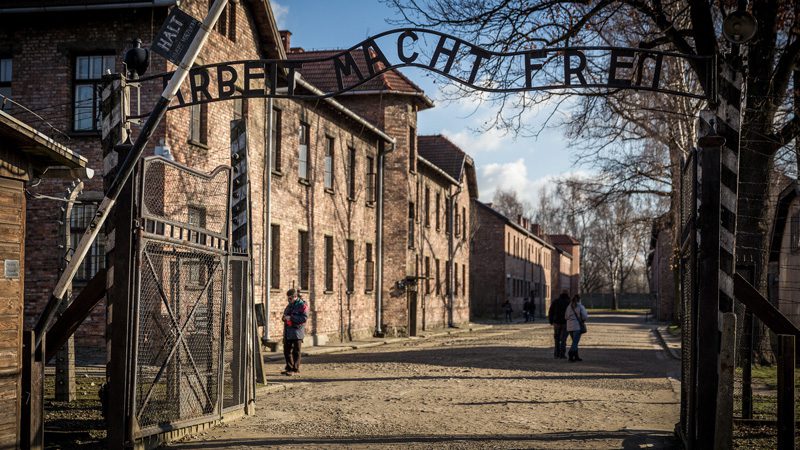
A couple of years ago, my girlfriend and I were hostelling our way through central Europe. We’d made it to Berlin, which is a little like those crossroads in movies, the ones with a dozen signs pointing in every possible direction.
There were too many choices as to what to do next. We could head north into Denmark, west to the Netherlands and Belgium, or south into the Czech Republic.
“What about Poland?” my girlfriend said. “We could see Auschwitz.”
The drive from Krakow
A couple of days later I was bouncing along in a small bus through the green lanes of southern Poland, just outside Krakow. The driver didn’t speak any English, nor did the other four sullen Poles on board. When we mentioned the word Auschwitz the driver just grunted and gestured to the seats.
The drive from Krakow to the old camp doesn’t take long. After thirty minutes we stopped on a road like any other road. A few of us got off and the bus rumbled away. Opposite was a shady boulevard lined with birch and oak trees. Glance up and you could just make out the red bricks and roofs of Auschwitz I, the original camp built by Polish political prisoners in the early 1940s.
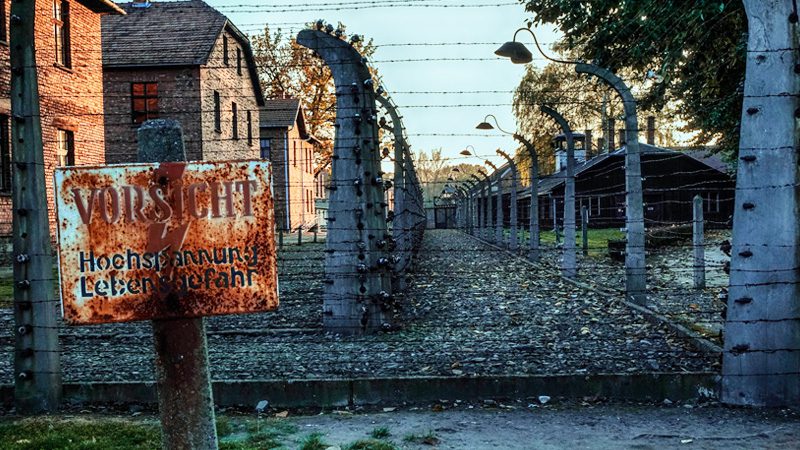
Auschwitz I. Image Thomas Hee, Flickr
Auschwitz I
On busy days, over 30,000 tourists will walk through the grounds of Auschwitz. Dozens and dozens of tours run simultaneously through the old camp and Birkenau, a few minutes down the road. As such, they run a pretty efficient ship. When you arrive you sign up for a tour time and are equipped with a pass, headset and radio. Your guide has a microphone and a transmitter, so all you need to do is tune in to their frequency. You begin where so many prisoners once did, beneath the rusted metal words “Arbeit macht frei” (work makes you free).
The next few hours are hard to describe. Your guide leads you through the avenues and neat brick houses of Auschwitz I. There are bare dormitories, old corridors, chilly parade grounds and – everywhere – double lines of razor wire poles, each equally spaced from its neighbour, and arched in a candy cane curve.
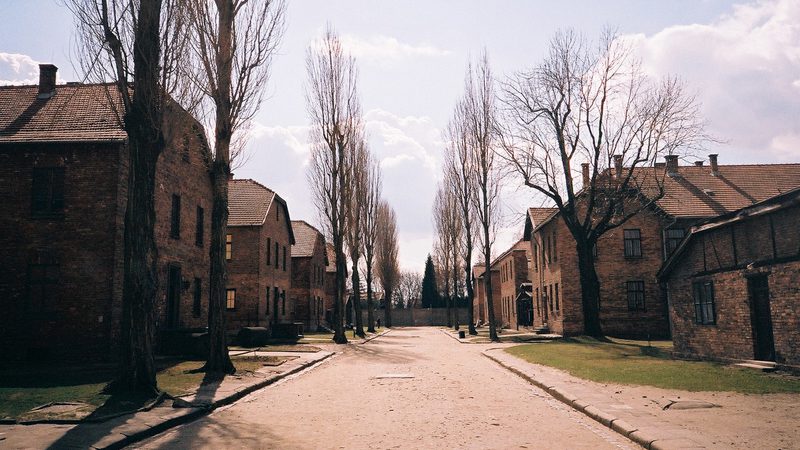
Image c/o Monica Kelly, Flickr
In every room, rows and rows of faces stare out from the walls: old prisoner profiles in black and white. Most look blank and empty; they portray nothing. But studying them is worth the price of admission alone. You could look at the eyes for hours, searching for a glimmer of hope, a pang of fear or a hint of determination. You can’t help but wonder what they were thinking.
Your guide says, “Three weeks after these were taken, all these people were dead.”
Every piece of the place has a story attached. Here a room, three feet by three feet, where four men were made to stand in the dark until they died. There the square outside notorious Block 11, the prison within a prison, where inmates were routinely executed against a brick wall. The house of the camp commandant, Rudolf Hoss, and the gallows where he was executed by the Allies in 1947. The gas chambers, the piles of hair, glasses, shoes… children’s toys.
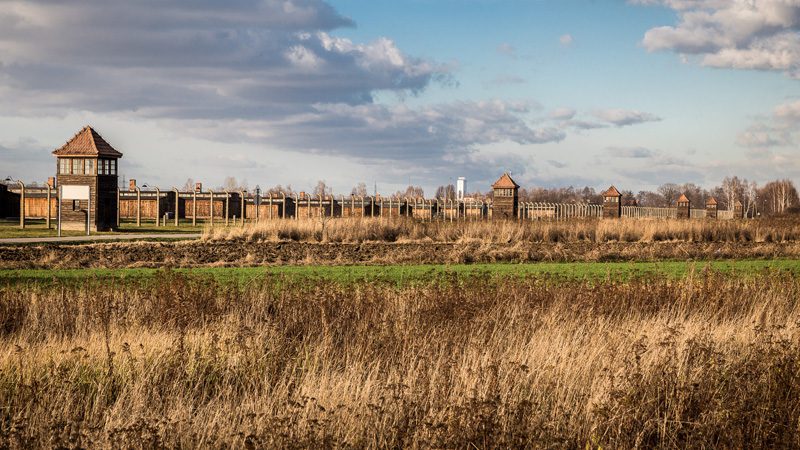
The fields of Birkenau. Image Mattia Panciroli, Flickr
Tourism in Auschwitz has attracted some criticism in recent years (the alleged ‘death tourism’) but I don’t really buy into it. You can criticise the actions of individuals, sure, but I think educating and illuminating future generations on one of the darkest times in human history can only be a good thing. Just like Winston Churchill said: “Those who do not learn from history are doomed to repeat it.”
After the original camp, the tour moves to Birkenau, which is an experience in itself. The close streets and heaviness of Auschwitz I are replaced by acres of grass, clear skies and two parallel railway tracks that come to an ominous, and very final, stop. There’s a warped tranquillity in Birkenau. Yellow wildflowers grow beneath the guard towers. You can see nearby villages and rolling hills. There’s the warble of distant birdsong. It’s hard to imagine that up to 20,000 people per day were killed and burned here. Apparently the nearby residents, the ones who hadn’t been rounded up in the first few years of Nazi occupation, could see and smell the smoke for miles. They slept with the distant glow of the ovens outside their window.
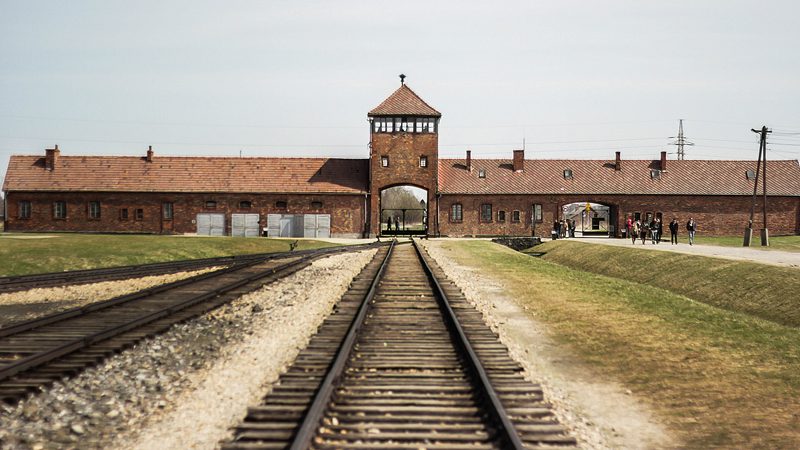
Image c/o Nick Perrone, Flickr
A visit to Auchwitz is the difference between reading the music and hearing it played. You can read about the horrors that happened there, watch documentaries that give you all the facts, but until you stand in the gas chambers, hear the eerie silence around the ash pools of Birkenau and see the dusty wooden bunks where prisoners would huddle together – you won’t understand it.
At the end of the tour you’re left standing outside the red brick main entrance to Birkenau. I remember thinking how quiet the place was. Even with so many people in it. there was so much silence in that place.
Travellers can visit Auschwitz on some of our trips through Poland . All entry fees to the World Heritage Site go towards preserving the camp for future generations.
Feature image c/o Matti Panciroli, Flickr

Feeling inspired?
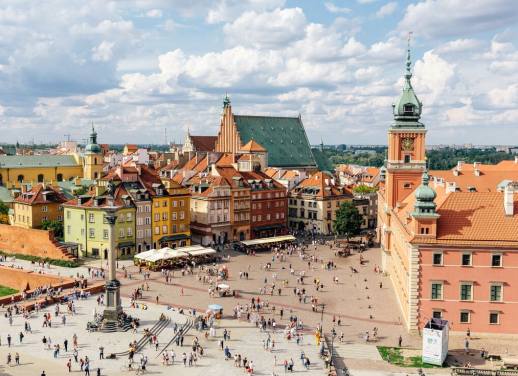
James Shackell
I was born in 1987 and aged from there. I like the sound of pop-rocks and dislike the sound of styrofoam. The length of my forearm is approximately the same as the length of my shin. My favourite Beatle is Ringo. I believe that junk food tastes so good because it’s bad for you and that your parents did the best job they knew how to do. If Johnny Cash wrote a song about my travels it would be called ‘I’ve been to several places but still have many other destinations on my to-do list, man’. Sometimes I have trouble finishing sen
You might also like
Galapagos or madagascar which unique destination should be..., travelling to chile here’s the best time to..., 10 reasons to visit samoa, the 10 antarctica questions you want answered, australia or new zealand where to go on..., 10 epic spots to stop at on your..., small group travel vs coach tours: which style..., costa rica or mexico: which country to check..., 7 of the best destinations for solo travellers..., machu picchu or chichen itza which historical site..., the people you meet: the art of connecting....
- South Africa
- El Salvador
- Bosnia and Herzegovina
- North Macedonia
- Czech Republic
- Transnistria
- Liechtenstein
- North Cyprus
- New Zealand
- Map with posts
- Alternative Guides
- Architecture Guides
- Cafe Guides
- Itineraries
- Neighborhood Guides
- Travel Guides
- Travel Tips
- Photo Galleries
- Photo Locations
- Solo female travel
- Train Travels
- Work with me
- Privacy Policy
Visiting Auschwitz – How to Plan the Auschwitz Tour
Visiting Auschwitz, albeit a very somber experience, is one of the must things to do in Poland. The largest Nazi Germany concentration and extermination camp during World War II, where over 1,3 million people lost their lives, needs no introduction. Conveniently located near Krakow , Auschwitz can be an easy addition to your Poland itinerary.
It took me almost 37 years to finally visit Auschwitz (although I’ve been to other Nazi Germany camps in Poland), and even if I knew very well what to expect, the place still overwhelmed me with its cruelty and tragedy. And I think everyone should plan a trip to Auschwitz to understand history better and see what people are capable of when the ideology brainwashes them. And, of course, to pay respect to all the unnecessary victims. It’s important to visit places like Auschwitz so we can do our best to prevent similar tragedies from happening in the future.

If you are visiting Poland (especially Krakow , Warsaw , Katowice , or Wroclaw ), I prepared this guide to help you plan your Auschwitz tour without too much hassle. There are different ways to visit Auschwitz, but no matter which one you choose, be prepared for one of the most difficult yet necessary travel experiences of your life.

Table of Contents
Where is Auschwitz
The former Nazi Germany Concentration Camp, Auschwitz-Birkenau, is located in a town of around 37.000 inhabitants called Oświęcim in southern Poland. Krakow is less than 70 km away, and Katowice is 35 km away. Warsaw, the capital of Poland, is around 330 km away from Oświęcim.
A brief history of Auschwitz
Even if Auschwitz is known mainly as the extermination camp, it was established as a concentration camp in mid-1940. It was one of over 40 camps in Poland that were supposed to be a solution to the problem of overflowing prisons full of arrested locals. The first people were brought to Auschwitz on June 14th, 1940, from the prison in Tarnow.
Since 1942 Auschwitz has also been used as the extermination camp where Nazis implemented their plan to murder Jewish people from all over Europe. At the peak of its operation, in 1944, Auschwitz was divided into three parts: Auschwitz I (the oldest one, in the old Polish military barracks), Auschwitz II-Birkenau (the largest one, founded in 1941, the majority of victims were killed here), and Auschwitz III (this was a group of over 40 sub-camps created near industrial plants, made for work prisoners).
Numerous Polish villages were demolished, and locals were evicted to develop such a large institution. The camps were isolated from the outside world. The total area was around 40 square kilometers, including all three Auschwitz camps and the so-called “interest zone” used for the technical or supply background, offices, and barracks for Nazis.
Since Auschwitz had a strategic location on the front line, in August 1944, the camp’s liquidation began – the prisoners were taken to Germany, and the evidence of the crimes was covered up. The liberation of Auschwitz took place on January 27th, 1945, when around 7,5 thousand prisoners were still held there.
Altogether, in the almost four years of operation, over 1,3 million people lost their lives in Auschwitz; the majority were Jewish (around 1,1 million), but also Polish (about 150 hundred thousand), Roma people (23 thousand), and other nations.
In 1979 Auschwitz was included in the UNESCO World Heritage List – it is the only former Nazi concentration camp with that title in the world.
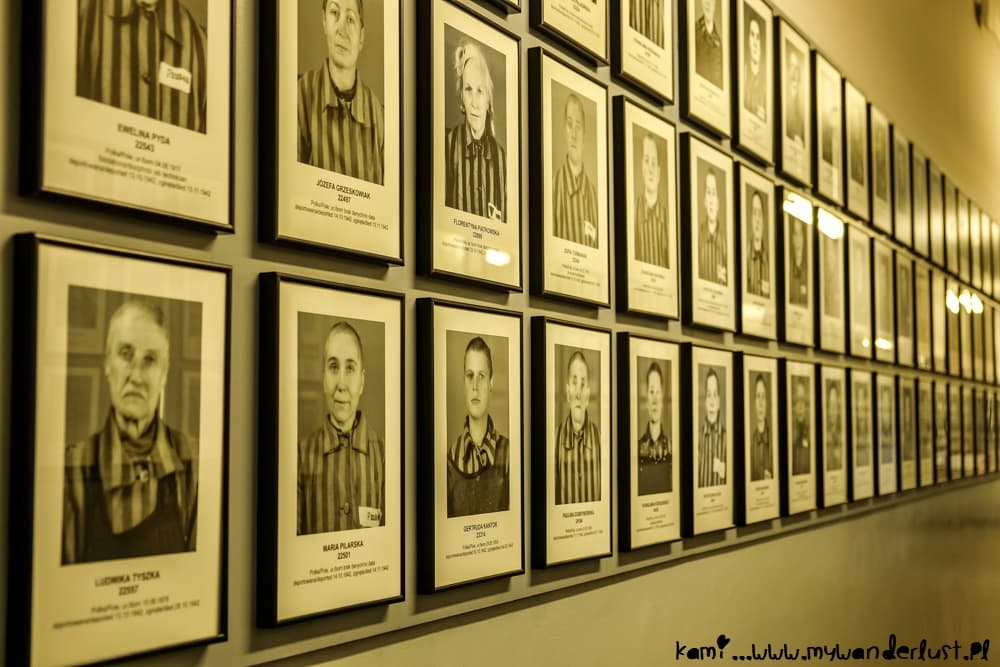
How to visit Auschwitz
You can visit Auschwitz two ways: with a tour from where you are staying in Poland (most likely Krakow, Katowice, Warsaw, or Wroclaw) or independently, reaching the site by car or using public transport. Both options are doable; however, the tour is a slightly better one as everything will be taken care of for you.
There is a wide selection of tours to choose from that depart from Krakow as well as other mentioned cities. Most of them cover more or less the same things: pick-up from your accommodation, transportation to/from Auschwitz and back, the entrance ticket to the concentration camp, and the guided tour on-site.
When I visited Auschwitz, I arrived by train from Warsaw, with the change in Katowice. I was at the museum almost an hour before my guided tour of the site was supposed to start, and despite the poor weather (it was raining on that day), there was no place to hide and wait for the tour. Visitors were not allowed to enter the museum until a few minutes before the tour was about to start. Me and a few other unlucky visitors just stood near the trees, hiding under the umbrella and waiting for our time to enter the site. I can’t say it was a comfortable situation (but at least the weather worked perfectly well for such a sad place to visit). Recently, a new visitors center was opened so hopefully the situation is better.
When using public transport, you need to rely on the schedule of trains/buses and, just in case, plan to be at the site with some extra time ahead; hence a tour is a better option. Still, visiting Auschwitz is doable independently – I did it, and once the tour of the site started, it was really good.

Visiting Auschwitz – practical information
Visiting Auschwitz memorial site is free of charge; however, I recommend joining the tour with the educator provided by the museum. They have a huge knowledge of the place and the tragedy that occurred here and can answer all the questions visitors always have. Tours are available in various languages: Polish, English, German, French, Spanish, Italian, Russian, Czech, and Slovak.
Even if you decide to visit the site independently, you still need to book the entry pass – those with free entrance start in the afternoon. You can buy/reserve your ticket online at the website of Auschwitz Museum here.
Currently, the price for the tour with the educator is 80 PLN for Polish and 90 PLN for other languages. When booking the ticket, you must state your full name and surname – this will be checked later.
Since tickets can sell out quickly, booking one at least a month in advance is recommended. If there are no tickets left for the day you want to visit Auschwitz, you can join the organized tour from Krakow or other cities, as tour operators usually have tickets booked in advance. Due to the sensitive nature of the place, children under 14 years old should not visit Auschwitz Museum.
Once you have your ticket, you need to arrive at the Auschwitz visitors center 30 minutes before your tour starts to go through the security check (it’s rather thorough, similar to the airport), have your ticket inspected (remember to have the ID or passport with you), get the headset for the tour and meet your group. You are allowed to have a bag or backpack with a maximum dimension of 30x20x10 cm; any larger luggage must be left in the paid lockers.
Auschwitz Museum is open every day except January 1st, December 25th, and Easter Sunday. Opening hours vary depending on the month and are as follows:
- 7:30-14:00 in December
- 7:30-15:00 in January and November
- 7:30-16:00 in February
- 7:30-17:00 in March and October
- 7:30-18:00 in April, May, and September
- 7:30-19:00 in June, July, and August
The closing time means the last entrance – after that, you are allowed to stay on-site for an hour and a half. However, if you want to see Auschwitz Museum properly, you need at least 3,5 hours for that – that’s also how long the standard tour with the educator lasts. It is usually divided equally between Auschwitz I and Auschwitz II- Birkenau. A free shuttle bus runs between the two sites every few minutes.
Taking pictures and making videos is allowed in Auschwitz, for individual use, except in two places: the hall with the hair of Victims (block nr 4) and the basements of Block 11. Your educator will remind you not to take pictures there.
Remember what sort of place you are visiting and behave there with respect. It might be obvious for most, but I can’t count how many times I’ve read news about inappropriate behavior in Auschwitz and other similar sites in Poland, so I think it’s worth reminding this is not your typical tourist attraction but a place of one of the greatest tragedy that ever happened in the world.

Getting to Auschwitz independently
If you decide to visit Auschwitz on your own, you must get to the visitors’ center, where your tour will start. The new visitors center, which opened just recently, is located at 55 Więźniów Oświęcimia Street in Oświęcim ( here is the exact location ). If you drive there, there is a large parking lot where you can leave your car before visiting the museum.
If you use public transport, there are both trains and buses you can take to reach Oświęcim. I recommend trains as they are slightly faster and more comfortable; however, some buses stop next to the museum, so that’s convenient. You can check all the connections on this website , where you can also find the location of the bus stop in Oświęcim (there can be three different ones).
The train station in Oświęcim is located at Powstańców Śląskich Street, some 20 minutes walking from the Auschwitz museum. It’s a straightforward way; you can check the map with the directions here . I recommend catching the train that gives you at least an hour between arriving at Oświęcim and when your tour starts.

Auschwitz tour from Krakow
Numerous Auschwitz tours depart from Krakow, so you will easily find the one that suits your itinerary and needs. Here are some recommended ones:
- Auschwitz-Birkenau Museum and Memorial Guided Tour from Krakow
- Auschwitz & Birkenau – Fully Guided Tour from Krakow
- Auschwitz-Birkenau Guided Tour with Private Transport from Kraków
- Auschwitz-Birkenau Guided Tour by Private Transport from Krakow
You can also combine visiting Auschwitz with Wieliczka Salt Mine , another UNESCO-listed site near Krakow and a must-visit place in Poland. Here are the tours that go to both places in one day:
- Day Trip to Auschwitz-Birkenau and Wieliczka Salt Mine from Krakow including Lunch
- Full-Day Tour of Auschwitz and Wieliczka Salt Mine from Krakow
- Auschwitz-Birkenau and Salt Mine Tour with private transport from Krakow
- Combined: Auschwitz Birkenau and Salt Mine private chauffeur from Krakow
If you decide to go to Auschwitz from Krakow on your own, you can take the train from the main train station to Oświęcim. They are rather frequent, more or less every hour, and the journey takes a bit over an hour (depending on the connection, the longest one is 1h20min).
If you want to take the bus, they depart from the MDA bus station, next to the main train station. The price for trains and buses is similar, between 15 and 20 PLN, although trains tend to be cheaper and faster. You can check all the connections and buy a ticket here .

Auschwitz tour from Warsaw
Even if Warsaw, the capital of Poland, is located over 300 km away from Oświęcim, it is possible to go for a one-day Auschwitz tour. However, you can expect a long day, and a large part of it will be spent traveling. But if you are visiting Warsaw only, Auschwitz can be a good addition to your Poland itinerary, so you can better understand the country’s complex history.
Here are some of the recommended Auschwitz tours from Warsaw:
- From Warsaw Auschwitz and Krakow one day tour by train with pick up and drop off
- One day tour to Auschwitz-Birkenau from Warsaw with private transport
Going for the day trip from Warsaw to Auschwitz independently is also possible using trains. You can take the 6 am train to Katowice and then change for the train to Oświęcim, arriving in the town around 10:30. If you decide to do that, you can book your Auschwitz tour for 11:30 or 12:00. On the way back, you can catch the train after 16:00 from Oświęcim to Katowice, and after changing for the train to Warsaw, you will be in the capital after 20:00.

Auschwitz tour from Katowice
Since Katowice is less than 40 km from Auschwitz, it’s easy to go for a day trip. You need to take the local train to Oświęcim, it takes less than 50 minutes, and the connections are more or less every hour.
Or you can go for a tour, here are the Auschwitz tours from Katowice:
- Auschwitz – Birkenau from Katowice
- Auschwitz & Birkenau English guided tour by private transport from Katowice
- Auschwitz tour from Wroclaw
Wroclaw is another popular place to visit in Poland, and since it’s located around 230 km from Oświęcim, you can go for an Auschwitz tour from Wroclaw too. If you decide to do it independently, you can take the train to Katowice and then change for the local train to Oświęcim. A one-way trip should take you less than 4 hours.
Or you can go for a tour; here are the recommended ones from Wroclaw:
- Auschwitz-Birkenau Tour from Wrocław
- Private Full-Day Tour to Auschwitz-Birkenau from Wroclaw
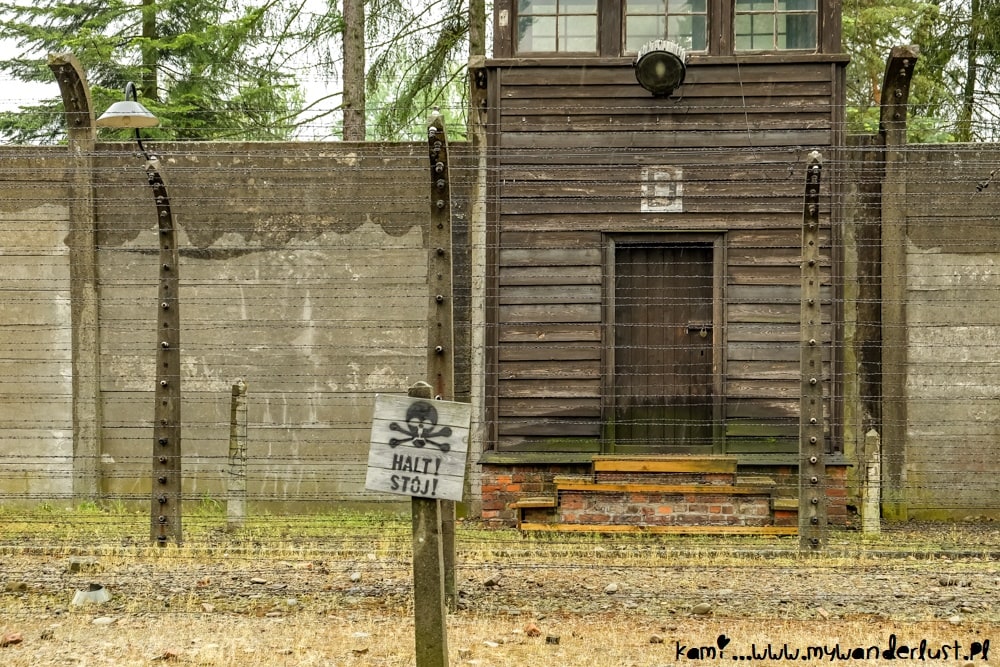
Auschwitz Museum Tour
As for the museum itself, here is what you can expect.
You will start in the oldest part of the concentration camp – Auschwitz I, where the infamous gate with the sign “Arbeit macht frei” (meaning “Work Sets You Free”) is located. Here, you will visit numerous barracks where inmates were kept – now you can see different exhibitions there, showing the reality of Auschwitz and halls with personal belongings taken from arriving prisoners – luggage, shoes, glasses, etc., or hair of Victims. You will learn all about cruel practices here, including medical experiments or torture.
Visiting this part of Auschwitz museum is a very somber experience, and it’s really difficult to comprehend the tragedy that happened in this very place.
Besides the barracks in Auschwitz I, you will also see where the camp commander lived or the first crematorium where Nazis started their experiments with killing using gas. In this part of the Auschwitz tour, you can take pictures everywhere except the two places in Blocks 4 and 11 – they will be clearly marked, and your educator will remind you about this restriction.
The visit to Auschwitz I takes around 1,5 hours. Afterward, together with your group and educator, you will take the shuttle bus to Auschwitz II-Birkenau, located some 3 km away.

Auschwitz II-Birkenau is where around 90% of victims died. It is a huge area that worked kind of like the killing factory, with four gas chambers and crematoriums. This is also where most prisoners arrived – you most likely know the view of the railway tracks and brick gate – that’s Auschwitz II-Birkenau. This part of the visit is mostly outdoors.
You will walk around the area, see the remnants of the camp, visit some barracks inside, and learn all about the horrific tragedy that happened here. When Auschwitz I has a more intimate, even claustrophobic feeling, Auschwitz II-Birkenau can overwhelm you with its scale and enormity.
You will spend around 1,5 hours here, too; afterward, you can take the shuttle bus back to the visitors center when you started your tour.
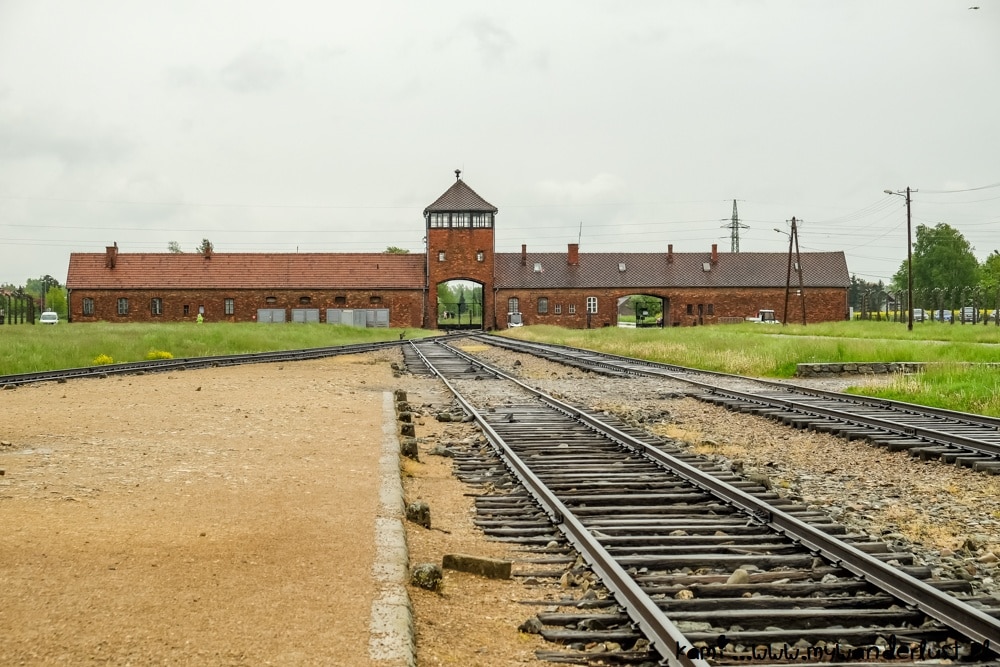
Final thoughts on visiting Auschwitz
Even though I’ve lived in Poland almost my whole life, and Auschwitz has been a familiar topic since I remember, it took me nearly 37 years to finally visit the place. Before I was in different Nazi Germany sites in Poland, mostly in Majdanek in Lublin, so I didn’t feel the need to visit Auschwitz too. But I don’t regret the decision to go there eventually.
You can read and learn about the place, but nothing can prepare you for visiting Auschwitz. Some areas look familiar (after all, pictures of the “Arbeit macht frei” sign or Birkenau gate are present everywhere), but you will still be overwhelmed by the place and seeing it in real life. It’s hard to comprehend the cruelty and tragedy that happened here, and dealing with all the thoughts invading your mind afterward can take a while. It can be one of the most difficult-to-understand places you will ever visit.
Still, despite it all, I think everyone should go to Auschwitz to see where fanaticism and totalitarianism can lead and why we should avoid them at all costs.
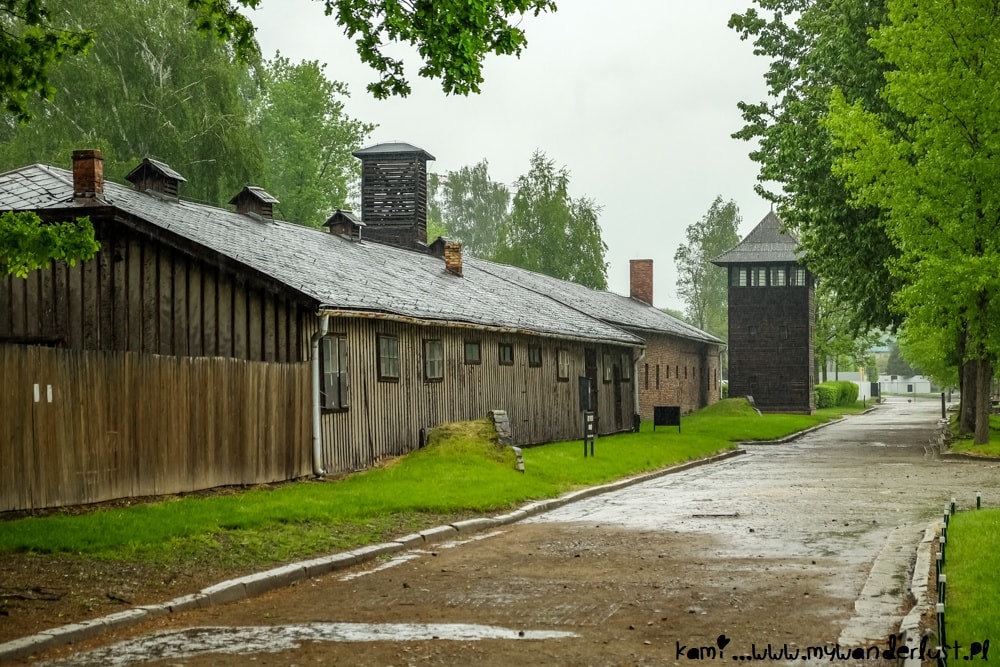
Travel Resources
You can find the best accommodation options at Booking . They have many discounts and excellent customer service. Click here to look for the place to stay in Poland
Never travel without travel insurance , you never know what might happen and better safe than sorry. You can check the insurance policy for Poland here.
I recommend joining organized tours to get to know the place better and to visit more places during your trip. You can find a great selection of tours at Get Your Guide – click here .
For the end I left a few announcements that might interest you:
- Sign up to my newsletter or follow me on Bloglovin to get updates about the new posts
- Join my Facebook group about Eastern Europe, the Balkans and former USSR and connect with fellow travellers and enthusiasts of these regions – just click here!
- I’ve included a few handy links of services and products I personally like and use so you can plan your own trip to Poland too. They are often affiliate links. This means I will get a small commission if you book/purchase anything through my links, at no extra costs for you. Thank you!
LIKED IT? PIN THIS POST FOR LATER!
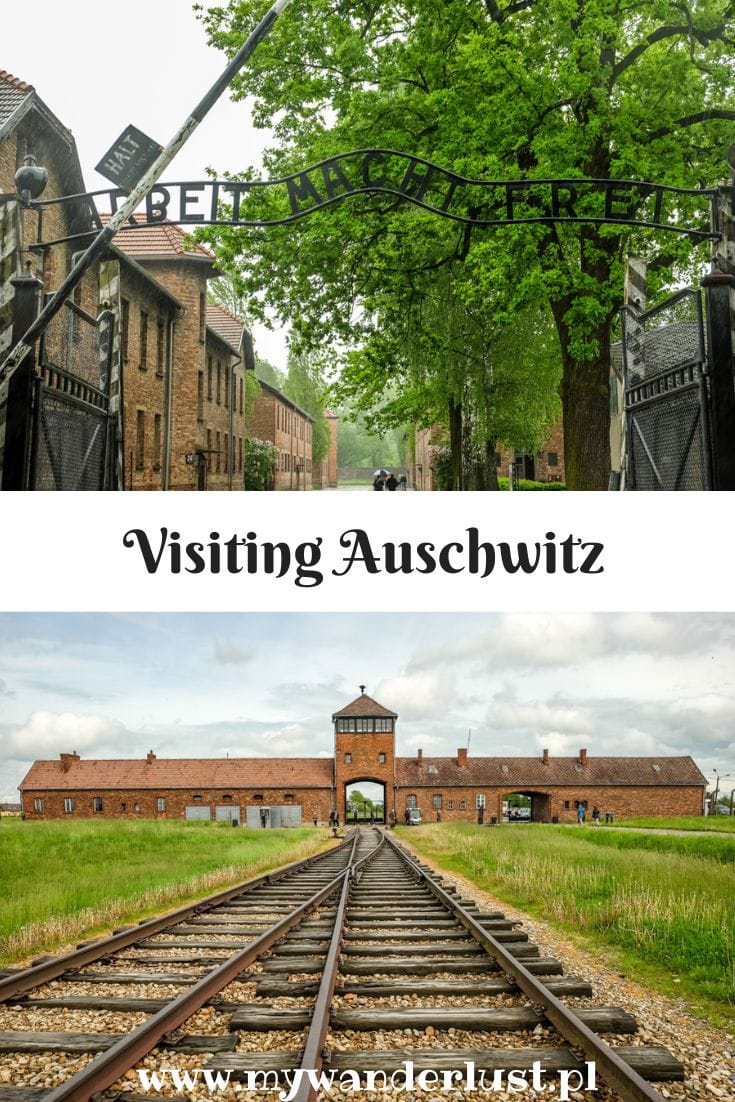
If you enjoyed that post why don't you share it with your friends? That would mean so much to me! Also be sure to join 30.000+ fellow travelers and follow me on Facebook , Twitter , or Instagram for travel updates and even more pictures! If you don't want to miss new posts sign up to my newsletter or follow on Bloglovin !

No Comments
Leave a reply cancel reply.
Sign me up for the newsletter!
Let’s become friends!
Join me on Facebook for even more travel updates!
Kami and the rest of the world

The Unforgettable Experience of Visiting Auschwitz Camps
As part of a week long trip to Eastern Europe, with our main destination set on visiting Auschwitz, I wasn’t quite sure what to expect during the visit. I know no better word to describe my visit to the two Auschwitz concentration camp sites than the word harrowing (extremely disturbing or distressing; grievous).
My Experience Visiting Auschwitz
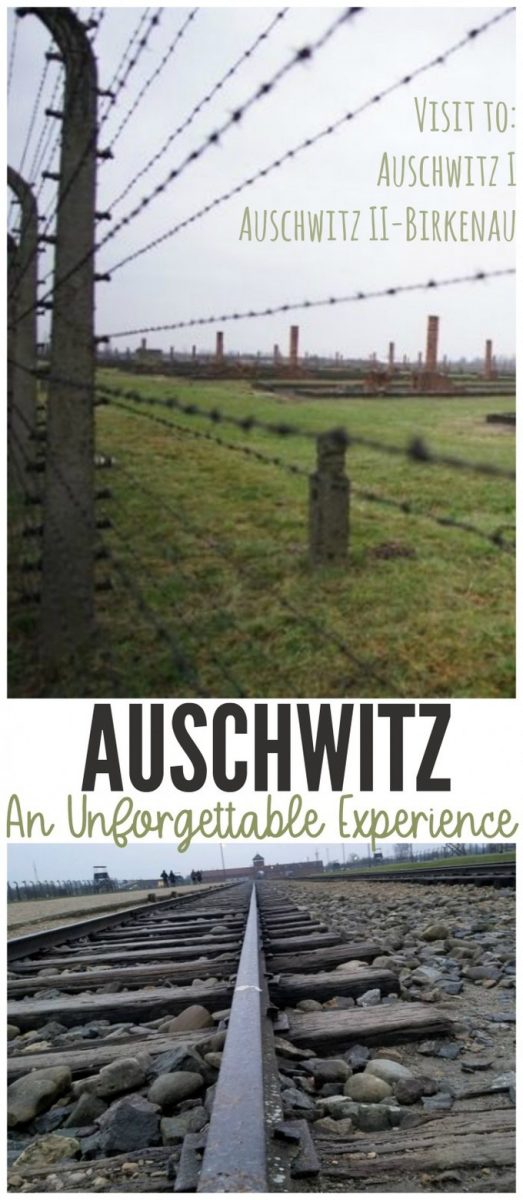
We spent about 6 hours between the two sites, and the visit is something that is nearly impossible to even describe. The best I can do is show you what I experience with a little bit of the history I learned while there and hope just a little piece of my experience can be carried over. This is a place everyone needs to visit when going to Eastern Europe. It is a place that just cannot be grasped without going there yourself.
Auschwitz I
Auschwitz, which had been a Polish barrack prior to World War II with the Germans took over Poland. The Nazi’s then used the site as a concentration camp initially to house Polish prisoners. The camp was expanded and eventually was large enough to house 16,000 people.
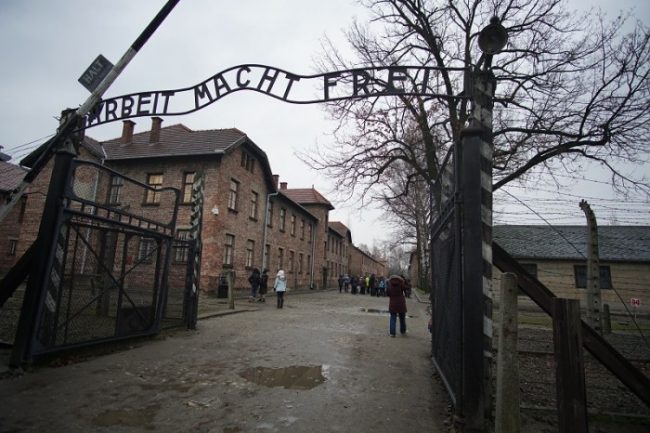
The entrance gate to Auschwitz was framed with the saying, “Arbeit macht frei” meaning “Work will set you free.” It was intended to give a false hope to the people imprisoned there. As we walked through the gate to what felt like a very large site we tried to comprehend the number of people that would have been imprisoned here.The guidebook said that by the end of the camp, there were 16,000 people imprisoned here.
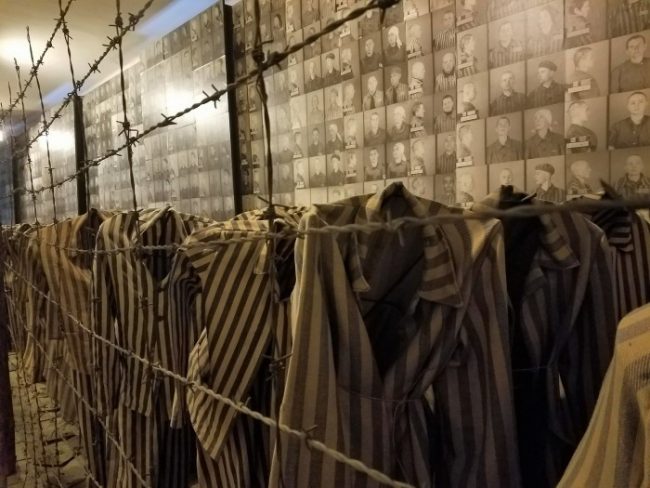
Many of the buildings held memorials and historical information about the events of the war and the things that happened here. It was hard to take in everything that we read and saw. One of the most moving exhibits was these rows of proped up striped uniforms behind barbed wire fencing. They looked as if marching to their death with a wall of actual photos of people from the camps in the background. It was a horrible thing that took place here, and it is so important that we learn about and remember what happened so that history is not repeated.
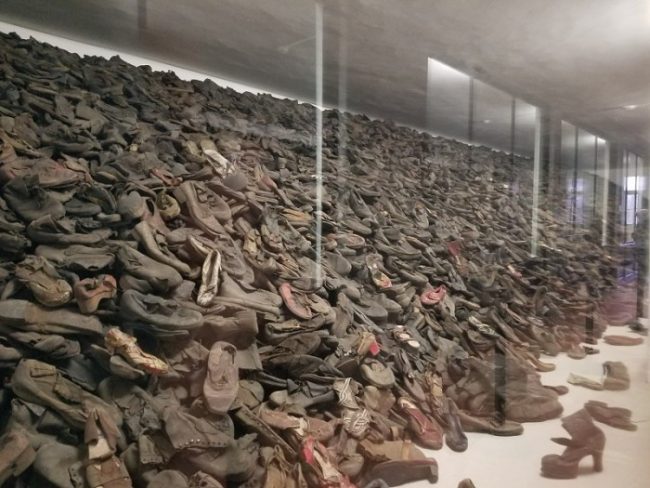
The heart wrenching memorials continued with exhibit rooms filled with belongings of the people from the Auschwitz camps – including their pottery, shoes, suitcases, even their hair which was crudely shaved from their heads before they were sent to work or to their death.
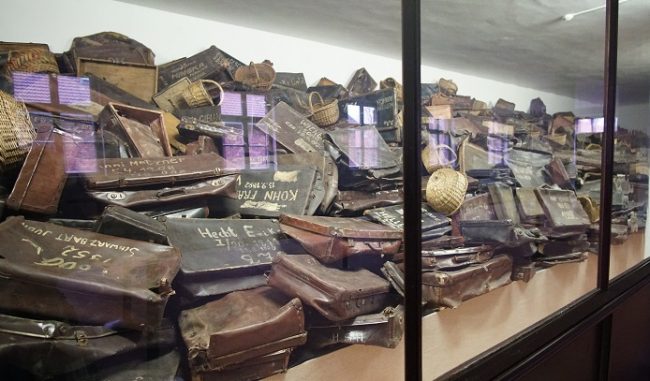
It was at Auschwitz I where they trialed the first crematory and gas chamber. Walking in through the gas chamber was something that is hard to put into words. You could just feel the impact of this place and see the claw prints on the walls from the innocent people who were locked in and poisoned by gas. The gas chamber lead to the crematorium where they would then dispose of the bodies by fire. This gas chamber was eventually put out of use as they expanded their extermination efforts with a series of gas chambers at the nearby Auschwitz II – Birkenau.
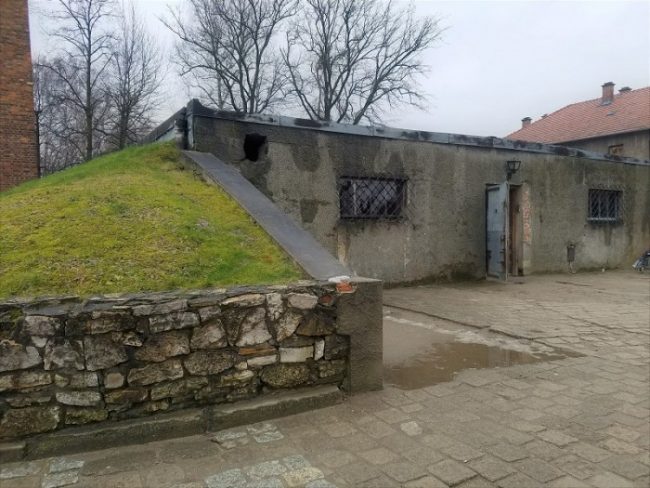
At Auschwitz I also experimented with mass sterilization, experimentation on twins, drug trials and more. These inhumane experiments left survivors permanently disabled and many were killed either for the experiments or during experimentation due to the effects. Many executions took place at Auschwitz as well.
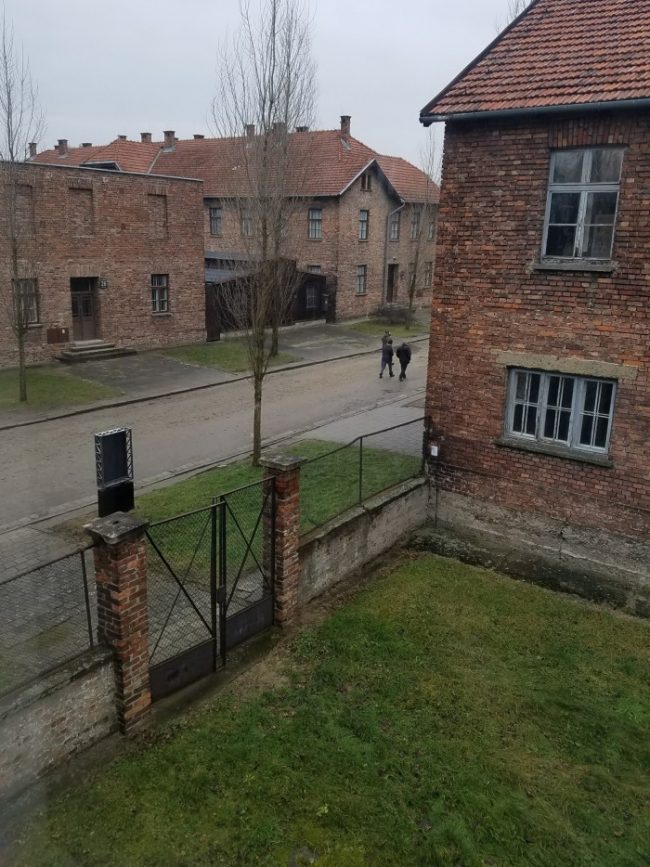
It was a place of so much death that it was hard to be there and experience everything that this place once was, but so important to do so. We spent about 3 hours at this camp, then went back to the apartment for lunch and to head to the second site.
Auschwitz II – Birkenau
Just 2 miles from Auschwitz I, the Germans began to build a second camp, Auschwitz II – Birkenau that would become the largest Nazi concentration camp and a place of mass extermination of Jews and other captives. It was important that we had visited Auschwitz I first to learn of the history and see the exhibits so that we could come to this second site with more awareness.
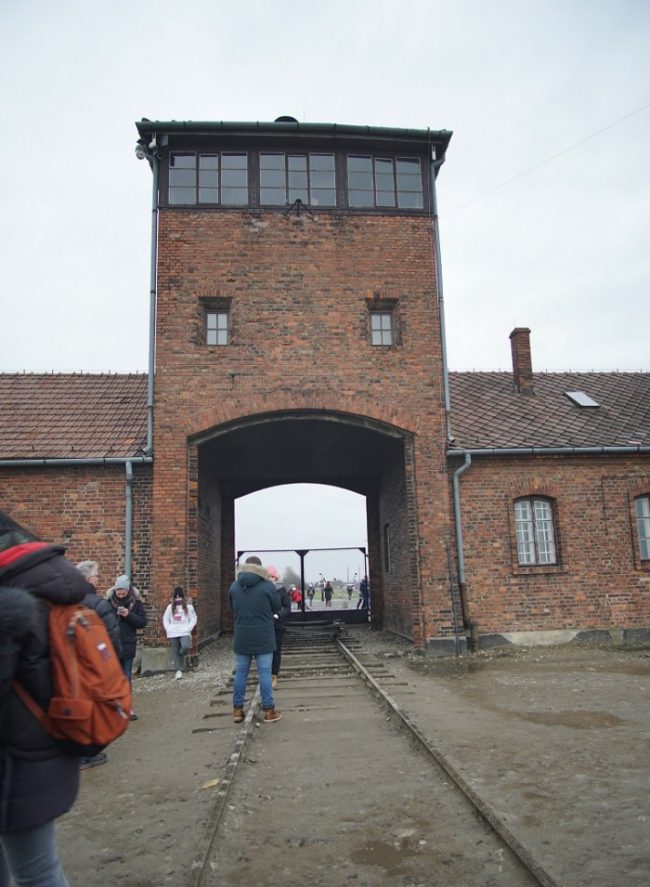
But when we walked through the large entrance gates and onto the railway tracks that brought so many people here we were completely blown away by the sheer size and capacity of this second camp. We had thought the first camp was large. This second camp, was impossible to grasp the magnitude.
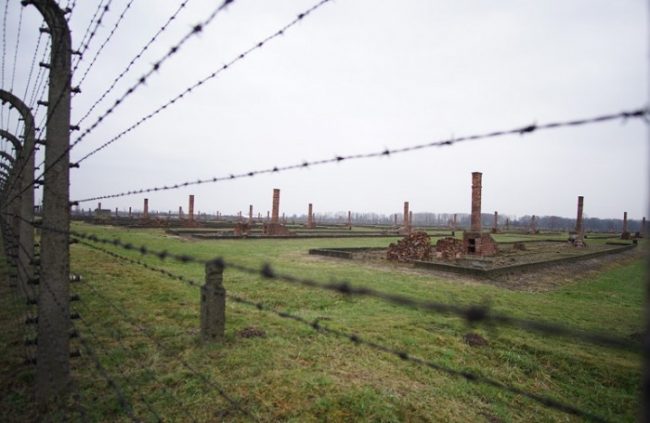
Most of the sites lay in ruins with just the brick fireplaces and foundation still in place, which makes it such a harrowing site to see cabin after cabin in ruins but as far as you could see in both directions. The camp was being built to hold 200,000 prisoners on 432 acres of land, but was only partially completed by the spring of 1944 with more than 300 buildings on the site and 11 miles of electrified barbed-wire fencing!
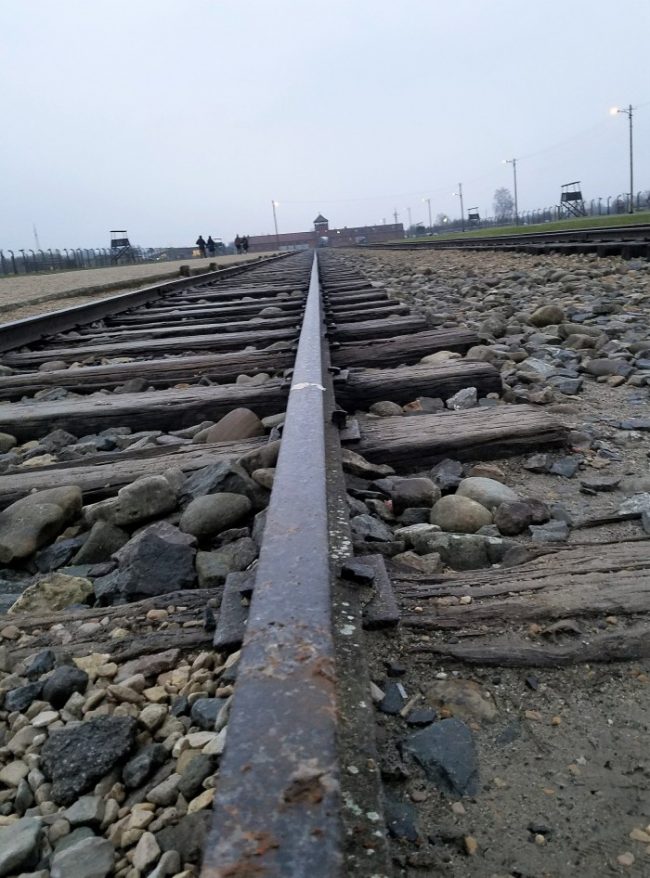
The tracks that ran right through the entrance of the camp to the very back of the camp brought in the prisoners who would then undergo a “selection” where the majority were deemed unfit to work. In most train loads brought in, 75% or more of the people were sent immediately to the gas chambers to be killed. We were able to see the ruins of these gas chambers, as they were destroyed towards the end of the war to hide evidence of their war crimes committed.
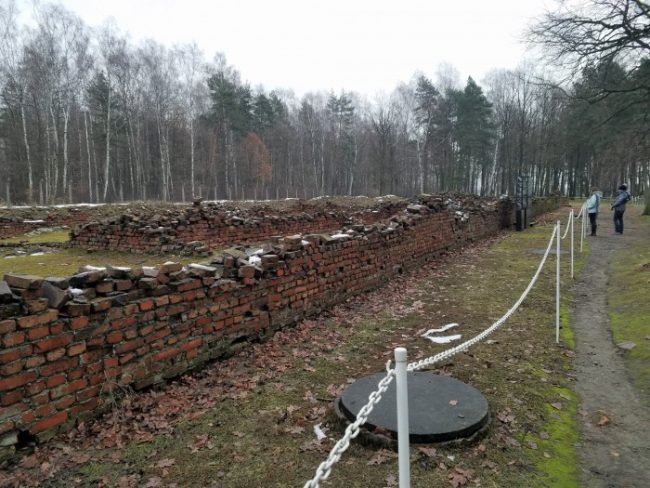
Those not immediately killed would be sent through an humiliating process at the “Sauna” house. The people would be filled through a series of rooms, sometimes taking hours between each of the rooms. Their belongings were taken from them including their clothing, their heads were crudely shaved, they were then showered en mass with often very hot or very cold water and disinfected. From there, they would be given a camp uniform and wooden clogs along with a camp number.
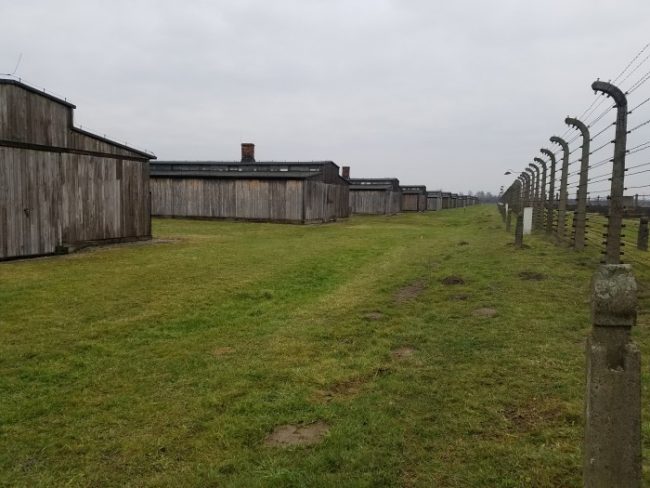
The people were then shuttled into one of the barracks. We were able to go into one of the wooden barracks that was designed to hold 400 people, with a total of 15 people per triple bunk. In practice, the bunk platforms would hold 10 people sleeping on simple straw mats with not enough room to even roll over.
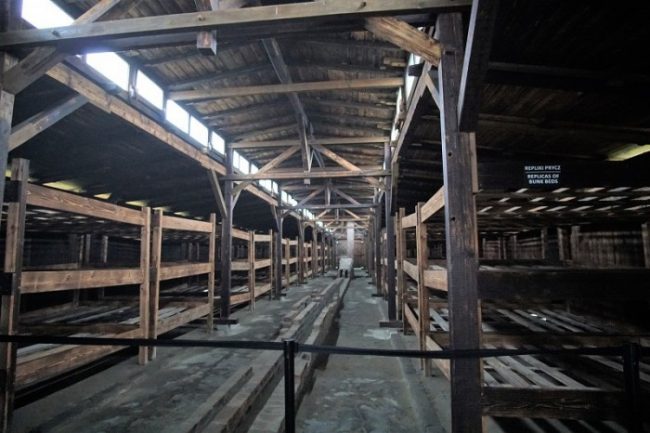
There was an incredibly moving display of the prisoners photographs of their peaceful and happy lives up until this horrific war. To see these thriving people that lived lives very similar to my own was heartbreaking. I tried to grasp all that they were put through during these terrible years, but it was impossible to experience the gravity of the events that took place here.
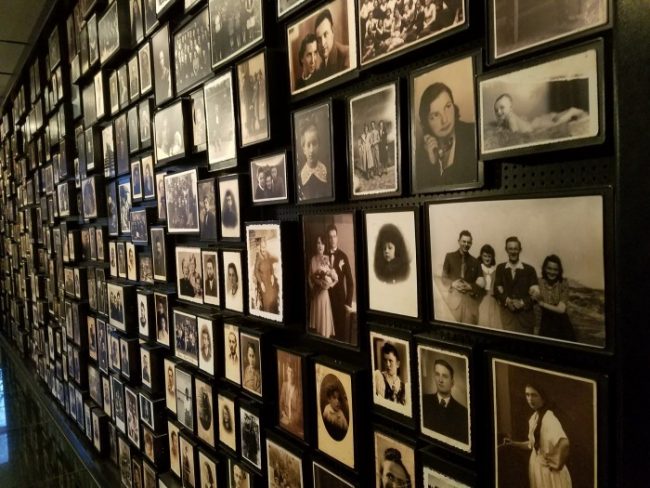
In the Auschwitz camps, it is estimated that over 1.3 million people were brought including over a million Jews. Of those brought to the camp, over 1,100,000 people were killed the majority of which were gassed and cremated. About 90% of the victims were Jews.
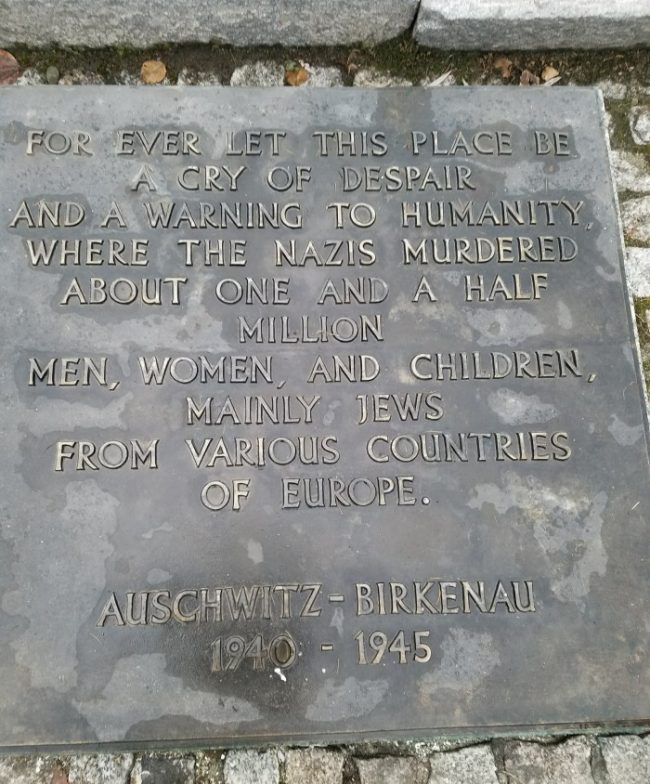
For ever let this place be a cry of despair and a warning to humanity, where the Nazis murdered about one and a half million men, women, and children, mainly jews from various countries of Europe.
Auschwitz – Birkenau 1940 – 1945
It is my hope that we will learn from the past and never let something like this ever happen again. In order to hold this resolve, we must try our best to grasp the cruelties that have happened at places like Auschwitz. By understanding them we will better be able to spot and fight against the cruelties of humanity and stand up against what is so clearly wrong.
I would absolutely recommend taking a trip to Auschwitz I and Auschwitz II – Birkenau, it is a place that everyone should visit as it is an experience you will never be able to forget.
To see how we set off on a 7-day vacation while sticking to a $1,000 budget, see our tips for budget-friendly travel .
Then, read about the rest of our journey through 5 different European countries . Auschwitz was just one of our stops, but needed it’s own post to cover this incredible place. Read on to experience the rest of our vacation including an easy itinerary you can follow!
Wednesday 10th of January 2018
Wow, this is heart breaking indeed, I am always interested in learning more about history. I couldn't even phantom living back in that time nor any of my family being in that camp. I would love to have my family visit Auschwitz concentration camp, I'm sure it would be very emotional that's for sure!
Tuesday 9th of January 2018
We went there several years ago, it really is a place you never forgot and leaves such a lasting impression.
I can only imagine how heavy it must be to be there, to know what had happened. I think it would be a meaningful experience to share with my family when all of my kids are a little older.
Monday 8th of January 2018
Thank you for posting this. As a Jew this is especially meaningful to me. Both sets of my Grandparents went through the war and were the only survivors of their entire family. My grandmothers were both sent to labor camps and managed to survive while one grandfather managed to stay alive by hiding in the forest and joining up with some partisans. My other grandfather was sent to Siberia and made it through! #neverforget
Friday 12th of January 2018
Oh man, you have a strong family! #fighters
We just watched Defiant last night and not sure if that was anything like your grandfather's experience, but it was definitely amazing all that they went through hiding in the forests!! I was so inspired that seeing these people through it all not lose their faith!
Desiree Lopez
It is an important thing that Auschwitz still stands so that we can be reminded of what happened here. I enjoy visiting historical places like this.
Is there an appropriate age to bring children to visit Auschwitz?
Jan 30, 2022 • 5 min read
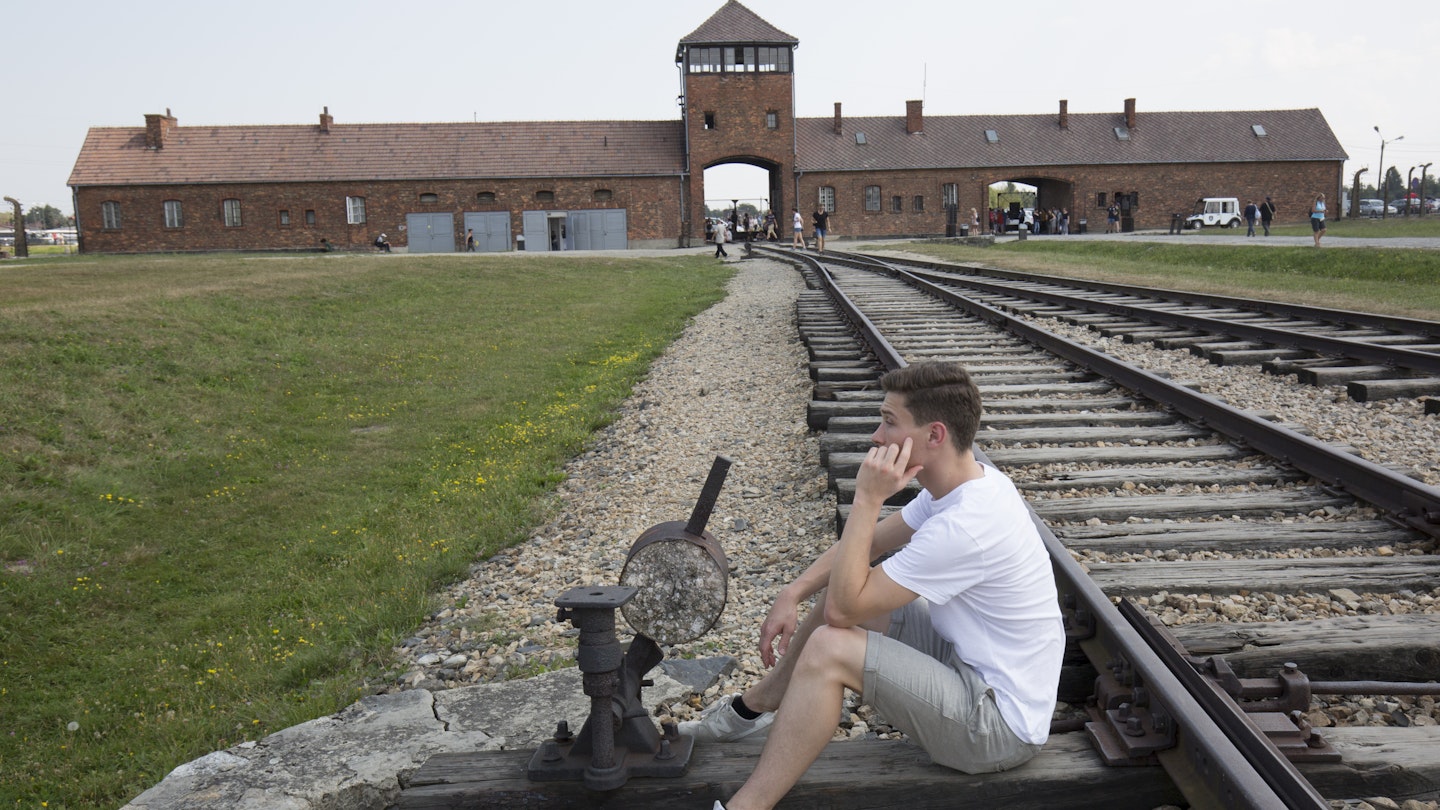
Understanding the Holocaust doesn’t come without distress © Ulrich Baumgarten via Getty Images
This week saw Holocaust Memorial services taking place around the world, as we marked the 77th anniversary of the liberation of Auschwitz Birkenau concentration camp by Soviet troops.
Since 1945, the former concentration camp has become a highly-visited historical site, with a record 2.15 million people taking the tour in pre-COVID 2018, many of them teenagers. But is there a ‘right’ age to bring a child or young person? Are children sometimes too young to be exposed to the horrors of the Holocaust? Official guidelines from memorial staff recommend that those under 14 do not visit. But this is just a recommendation, not a rule.

The remarkable plasticity of the teenage brain means there is an opportunity during these years to fundamentally affect, for good or ill, their understanding of the world. If we take time to expose young people to the kind of profound experience that is Auschwitz-Birkenau , there is great hope that they will form an impression that will stay with them; an understanding of the horrors humanity is capable of and a determination to be vigilant against them.
This seems to be generally recognized, with many secondary schools organising trips. In the UK , the Department for Education has funded a programme since 1999, with over 40,000 students and teachers taking part in the Holocaust Educational Trust's, Lessons from Auschwitz Project . This is based around the premise that 'hearing is not like seeing', and aims to increase knowledge and understanding of the Holocaust for young people.
What to expect on a visit to Auschwitz-Birkenau
“I wasn’t scared to go, I was interested,” says 18-year-old Harry O’Donoghue, who was 16 when he visited Auschwitz-Birkenau with his mother and grandfather. “We had studied the period at school, and I had an idea of what to expect.”
Of the two camps, Birkenau left a lasting impact on him. “The huge, grey buildings, the iron fences, the guard towers. Auschwitz didn't look as I had imagined it," he adds. “In essence, it is a vast field, with wooden shacks and barbed wire. Trying to imagine 750,000 people here was difficult. In Birkenau, looking at rooms full of shoes, of human hair, spectacles, that brought the scale of it home more.”
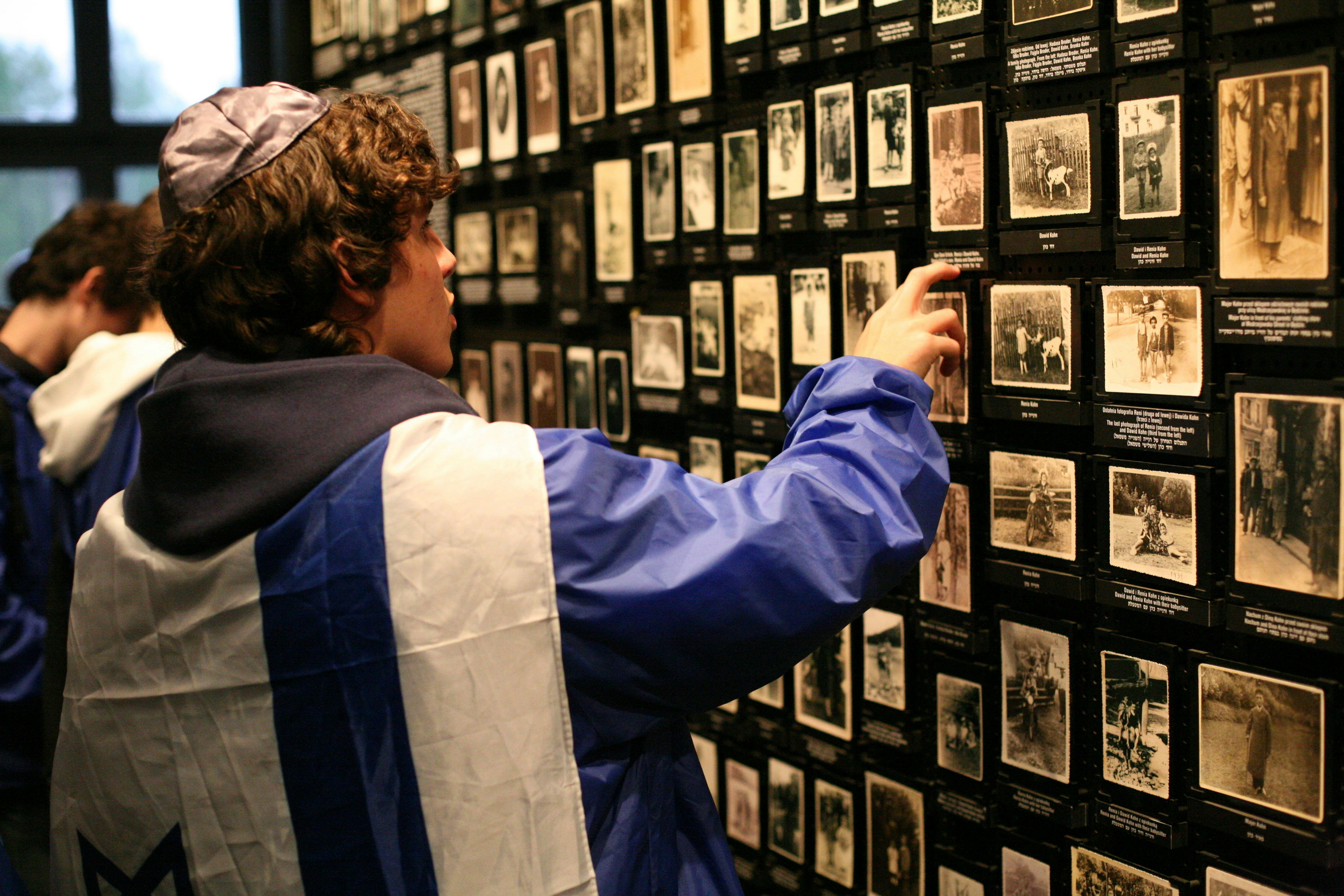
He found the suitcases and luggage the most distressing of all. The cases have labels on them, with names and dates of birth visible, so it's possible to calculate the age of the person to whom they belonged. A number of them are left open; seeing a pair of neatly folded pyjamas and a teddy-bear, packed by a three-year-old child, really affected him.
Understanding the Holocaust doesn’t come without distress. Teenagers are highly emotional, there is a chance that some will feel overloaded, helpless in the face of the greatest monument we have to inhumanity and evil. When asked if she had worried about taking him, however, Harry O’Donoghue’s mother, Deirdre , said no. Harry has always been an avid reader of history and he knew a lot about the period. The pair were also able to talk about it afterwards. Her father – now in his 80s – had always wanted to visit, too.

Emily Gleeson and a small group of classmates were warned that they might be overwhelmed when they visited Auschwitz-Birkenau.
For 14-year-old Emily, the impact was immediate: “We prepared before going, including watching movies like Schindler’s List, to get some idea of what we would see, which was good.” She was also taken aback by how real everything felt – Auschwitz is not dressed up, or a museum; things have been kept as they were.
Most distressing for her was the room full of hair and personal belongings: “All those shoes, that was very disturbing” she says. “Suddenly, the scale becomes more understandable. It’s impossible to imagine one million people, but when you see a room with suitcases piled high up to the ceiling, you can begin to get an idea.”
Donna Gawell, a historical novelist, took her two daughters to Dachau when they were 11 and 15. They later visited Auschwitz-Birkenau.
Building children into educated future voters
“It was a very profound visit for both [of her daughters] and I did little preparation with them as it was also my first time visiting," she says. "My daughters really appreciated the visit and for the next few years, used that experience as their topic for writing assignments in English and Social studies.”
Her youngest now reports that she is grateful for the trip, although she doesn't remember much. Donna believes it strengthened her and rendered her a more compassionate person. While Donna's daughter was shocked, she also says she wasn’t frightened or terrified and didn’t have bad dreams or anxiety about what she saw.
Donna continues: “I wouldn’t necessarily ask if my child wanted to go; I would make the decision for them. Most kids don’t realize what a unique experience they will have. Taking your child to Auschwitz is a gift to build them into a strong, compassionate, and educated future voter and citizen.”
Editor's note: during COVID-19 there are restrictions on travel. Check the latest guidance before departure, and always follow local health advice.
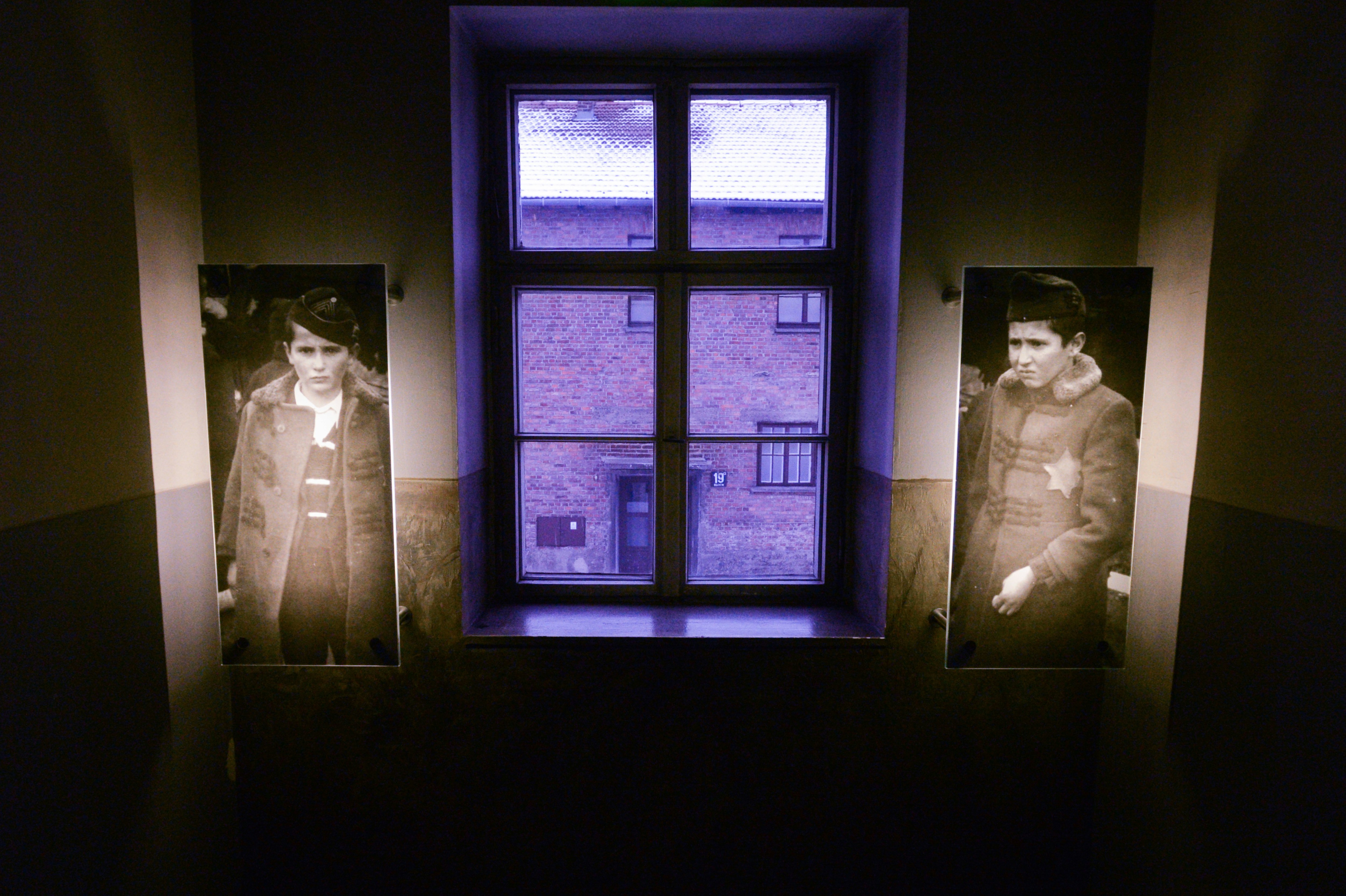
Not everyone welcomes young people at what is a place of solemn witness, sometimes of family trauma. There are stories of noisy groups taking selfies and behaving with a lack of respect. This may be the result of an inability to deal with the emotions raised, but it certainly comes across as callous. Emily's teachers were very clear with her and her classmates before they went about what was appropriate behavior, and the whole group stayed quiet.
Did the trip change the way she sees the world?
“I’m glad I went,” says Emily. “It was an eye-opener. It has changed the way I think – knowing that people can do that, can think like that.”
For Harry, it was definitely worth going: “It made me feel very sad – the coldness of it. Those places could have been built by robots. There was no human feeling in their design, and so obviously those who created them didn't think of the people they kept there as human. But it was important to see that.”
You may also like: The 70,000 small tributes to Holocaust victims that most people don’t notice Top 10 things to do in Poland
This article was first published December 2019 and updated January 2022
Explore related stories

Nov 30, 2020 • 5 min read
Be it roast turkey with all the trimmings, spicy meat stew, grilled seafood or even Kentucky Fried Chicken, ‘tis the season for feasting.

Feb 11, 2020 • 5 min read
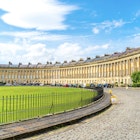
Feb 26, 2024 • 10 min read

Jan 17, 2024 • 7 min read

Nov 1, 2023 • 4 min read
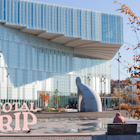
Oct 24, 2023 • 9 min read

Oct 19, 2023 • 8 min read

Oct 6, 2023 • 15 min read

Aug 11, 2023 • 4 min read
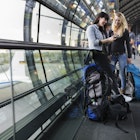
Aug 3, 2023 • 6 min read
- History Classics
- Your Profile
- Find History on Facebook (Opens in a new window)
- Find History on Twitter (Opens in a new window)
- Find History on YouTube (Opens in a new window)
- Find History on Instagram (Opens in a new window)
- Find History on TikTok (Opens in a new window)
- This Day In History
- History Podcasts
- History Vault
By: History.com Editors
Updated: January 24, 2024 | Original: December 15, 2009

Auschwitz, also known as Auschwitz-Birkenau, opened in 1940 and was the largest of the Nazi concentration and death camps. Located in southern Poland, Auschwitz initially served as a detention center for political prisoners. However, it evolved into a network of camps where Jewish people and other perceived enemies of the Nazi state were exterminated, often in gas chambers, or used as slave labor. Some prisoners were also subjected to barbaric medical experiments led by Josef Mengele (1911-79). During World War II (1939-45), more than 1 million people, by some accounts, lost their lives at Auschwitz.
In January 1945, with the Soviet army approaching, Nazi officials ordered the camp abandoned and sent an estimated 60,000 prisoners on a forced march to other locations. When the Soviets entered Auschwitz, they found thousands of emaciated detainees and piles of corpses left behind.
Auschwitz: Genesis of Death Camps
After the start of World War II , Adolf Hitler (1889-1945), the chancellor of Germany from 1933 to 1945, implemented a policy that came to be known as the “Final Solution.” Hitler was determined not just to isolate Jews in Germany and countries annexed by the Nazis, subjecting them to dehumanizing regulations and random acts of violence. Instead, he became convinced that his “Jewish problem” would be solved only with the elimination of every Jew in his domain, along with artists, educators, Romas, communists, homosexuals, the mentally and physically handicapped and others deemed unfit for survival in Nazi Germany.
Did you know? In October 1944, a group of Auschwitz "Sonderkommando," young Jewish males responsible for removing corpses from crematoriums and gas chambers, staged a revolt. They assaulted their guards, using tools and makeshift explosives, and demolished a crematorium. All were apprehended and killed.
To complete this mission, Hitler ordered the construction of death camps. Unlike concentration camps, which had existed in Germany since 1933 and were detention centers for Jews, political prisoners and other perceived enemies of the Nazi state, death camps existed for the sole purpose of killing Jews and other “undesirables,” in what became known as the Holocaust.
Auschwitz: The Largest of the Death Camps
Auschwitz, the largest and arguably the most notorious of all the Nazi death camps, opened in the spring of 1940. Its first commandant was Rudolf Höss (1900-47), who previously had helped run the Sachsenhausen concentration camp in Oranienburg, Germany. Auschwitz was located on a former military base outside Oswiecim, a town in southern Poland situated near Krakow, one of the country’s largest cities. During the camp’s construction, nearby factories were appropriated and all those living in the area were forcibly ejected from their homes, which were bulldozed by the Nazis.
Auschwitz originally was conceived as a concentration camp, to be used as a detention center for the many Polish citizens arrested after Germany annexed the country in 1939. These detainees included anti-Nazi activists, politicians, resistance members and luminaries from the cultural and scientific communities. Once Hitler’s Final Solution became official Nazi policy, however, Auschwitz was deemed an ideal death camp locale. For one thing, it was situated near the center of all German-occupied countries on the European continent. For another, it was in close proximity to the string of rail lines used to transport detainees to the network of Nazi camps.
However, not all those arriving at Auschwitz were immediately exterminated. Those deemed fit to work were employed as slave labor in the production of munitions, synthetic rubber and other products considered essential to Germany’s efforts in World War II.
Auschwitz and Its Subdivisions
At its peak of operation, Auschwitz consisted of several divisions. The original camp, known as Auschwitz I, housed between 15,000 and 20,000 political prisoners. Those entering its main gate were greeted with an infamous and ironic inscription: “Arbeit Macht Frei,” or “Work Makes You Free.”
Auschwitz II, located in the village of Birkenau, or Brzezinka, was constructed in 1941 on the order of Heinrich Himmler (1900-45), commander of the “Schutzstaffel” (or Select Guard/Protection Squad, more commonly known as the SS), which operated all Nazi concentration camps and death camps. Birkenau, the biggest of the Auschwitz facilities, could hold some 90,000 prisoners.
It also housed a group of bathhouses where countless people were gassed to death, and crematory ovens where bodies were burned. The majority of Auschwitz victims died at Birkenau. More than 40 smaller facilities, called subcamps, dotted the landscape and served as slave-labor camps. The largest of these subcamps, Monowitz, also known as Auschwitz III, began operating in 1942 and housed some 10,000 prisoners.
Life and Death in Auschwitz
By mid-1942, the majority of those being sent by the Nazis to Auschwitz were Jews. Upon arriving at the camp, detainees were examined by Nazi doctors. Those detainees considered unfit for work, including young children, the elderly, pregnant women and the infirm, were immediately ordered to take showers. However, the bathhouses to which they marched were disguised gas chambers. Once inside, the prisoners were exposed to Zyklon-B poison gas. Individuals marked as unfit for work were never officially registered as Auschwitz inmates. For this reason, it is impossible to calculate the number of lives lost in the camp.
For those prisoners who initially escaped the gas chambers, an undetermined number died from overwork, disease, insufficient nutrition or the daily struggle for survival in brutal living conditions. Arbitrary executions, torture and retribution happened daily in front of the other prisoners.
Some Auschwitz prisoners were subjected to inhumane medical experimentation. The chief perpetrator of this barbaric research was Josef Mengele (1911-79), a German physician who began working at Auschwitz in 1943. Mengele, who came to be known as the “Angel of Death,” performed a range of experiments on detainees. For example, in an effort to study eye color, he injected serum into the eyeballs of dozens of children, causing them excruciating pain. He also injected chloroform into the hearts of twins to determine if both siblings would die at the same time and in the same manner.
Liberation of Auschwitz: 1945
As 1944 came to a close and the defeat of Nazi Germany by the Allied forces seemed certain, the Auschwitz commandants began destroying evidence of the horror that had taken place there. Buildings were torn down, blown up or set on fire, and records were destroyed.
In January 1945, as the Soviet army entered Krakow, the Germans ordered that Auschwitz be abandoned. Before the end of the month, in what came to be known as the Auschwitz death marches, an estimated 60,000 detainees, accompanied by Nazi guards, departed the camp and were forced to march to the Polish towns of Gliwice or Wodzislaw, some 30 miles away. Countless prisoners died during this process; those who made it to the sites were sent on trains to concentration camps in Germany.
When the Soviet army entered Auschwitz on January 27, they found approximately 7,600 sick or emaciated detainees who had been left behind barbed wire. The liberators also discovered mounds of corpses, hundreds of thousands of pieces of clothing and pairs of shoes and seven tons of human hair that had been shaved from detainees before their liquidation. According to some estimates, between 1.1 million to 1.5 million people, the vast majority of them Jews, died at Auschwitz during its years of operation. An estimated 70,000 to 80,000 Poles perished at the camp, along with 19,000 to 20,000 Romas and smaller numbers of Soviet prisoners of war and other individuals.
Auschwitz Today
Today, Auschwitz is open to the public as the Auschwitz-Birkenau Memorial and Museum . It tells the story of the largest mass murder site in history and acts as a reminder of the horrors of genocide.
Images from the Death Camps

Sign up for Inside History
Get HISTORY’s most fascinating stories delivered to your inbox three times a week.
By submitting your information, you agree to receive emails from HISTORY and A+E Networks. You can opt out at any time. You must be 16 years or older and a resident of the United States.
More details : Privacy Notice | Terms of Use | Contact Us
Search the Holocaust Encyclopedia
- Animated Map
- Discussion Question
- Media Essay
- Oral History
- Timeline Event
- Clear Selections
- Bahasa Indonesia
- Português do Brasil
Featured Content
Find topics of interest and explore encyclopedia content related to those topics
Find articles, photos, maps, films, and more listed alphabetically
For Teachers
Recommended resources and topics if you have limited time to teach about the Holocaust
Explore the ID Cards to learn more about personal experiences during the Holocaust
Timeline of Events
Explore a timeline of events that occurred before, during, and after the Holocaust.
- Introduction to the Holocaust
- Liberation of Nazi Camps
- Warsaw Ghetto Uprising
- Boycott of Jewish Businesses
- Axis Invasion of Yugoslavia
- Antisemitism
- How Many People did the Nazis Murder?
- The Rwanda Genocide
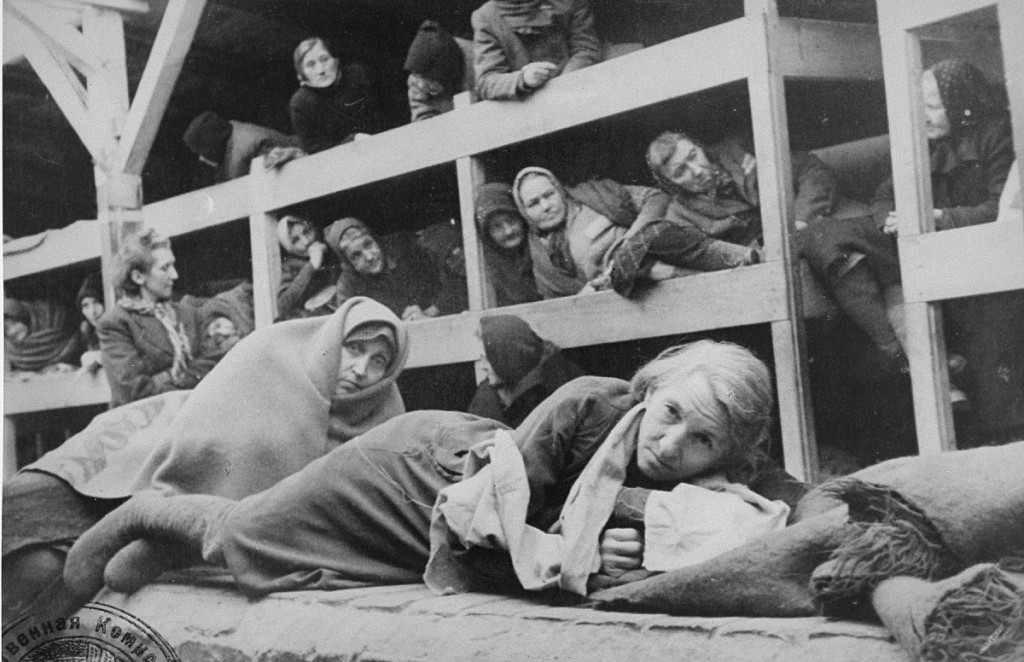
The largest of its kind, the Auschwitz camp complex was essential to carrying out the Nazi plan for the "Final Solution." Auschwitz left its mark as one of the most infamous camps of the Holocaust.
Located in German-occupied Poland, Auschwitz consisted of three camps including a killing center. The camps were opened over the course of nearly two years, 1940-1942. Auschwitz closed in January 1945 with its liberation by the Soviet army.
More than 1.1 million people died at Auschwitz, including nearly one million Jews. Those Jews who were not sent directly to gas chambers were selected for forced labor.
The Auschwitz complex differed from the other Nazi killing centers because it included a concentration camp and a labor camp as well as large gas chambers and crematoria at Birkenau constructed for the mass murder of European Jews.
- killing centers
- concentration camps
- medical experiments
- forced labor

This content is available in the following languages
Where was auschwitz located.
Auschwitz is the German name for the Polish city Oświęcim. Oświęcim is located in Poland, approximately 40 miles (about 64 km) west of Kraków. Germany annexed this area of Poland in 1939.
The Auschwitz concentration camp was located on the outskirts of Oświęcim in German-occupied Poland. It was originally established in 1940 and later referred to as "Auschwitz I" or "Main Camp."
The Auschwitz-Birkenau killing center, also referred to as "Auschwitz II," was located near the Polish village Brzezinka (German: Birkenau). This is about 2 miles (just over 3 km) from the Main Camp. The Germans started construction on Auschwitz-Birkenau in 1941.
Auschwitz III or Monowitz was located near the Polish village of Monowice (German: Monowitz). This is about 4 miles (approximately 6.5 kilometers) from the Main Camp. The Germans initially established the Buna subcamp there in 1942. In 1943, it became a concentration camp.
The Auschwitz camp complex also included numerous subcamps. The majority of these subcamps were located in the region around Auschwitz.
Number of Victims
It is estimated that the SS and police deported at least 1.3 million people to the Auschwitz camp complex between 1940 and 1945. Of these deportees, approximately 1.1 million people were murdered.
The best estimates of the number of victims at the Auschwitz camp complex, including the killing center at Auschwitz-Birkenau, between 1940 and 1945 are:
- Jews (1,095,000 deported to Auschwitz, 960,000 died)
- Non-Jewish Poles (140,000- 150,000 deported, 74,000 died)
- Roma (Gypsies) (23,000 deported, 21,000 died)
- Soviet prisoners of war (15,000 deported and died)
- Other nationalities (25,000 deported, 10,000- 15,000 died)
During the Holocaust , concentration camp prisoners received tattoos only at one location, Auschwitz. Incoming prisoners were assigned a camp serial number which was sewn to their prison uniforms. Only those prisoners selected for work were issued serial numbers; those prisoners sent directly to the gas chambers were not registered and received no tattoos.
Auschwitz I
SS authorities continuously used prisoners for forced labor to expand the camp. During the first year of the camp’s existence, the SS and police cleared a zone of approximately 40 square kilometers (15.44 square miles) as a “development zone” reserved for the exclusive use of the camp.
On May 20, 1940, the first prisoners arrived at Auschwitz. The transport consisted of some 30 German inmates, categorized as "professional criminals." The SS had selected them from the Sachsenhausen concentration camp outside of Berlin. Less than a month later, on June 14, German authorities in occupied Poland deported 728 Polish prisoners from a prison in Tarnow to Auschwitz. This was the first of many transports of Poles to the Auschwitz camp.
Like most German concentration camps, Auschwitz I was constructed for three purposes:
- To incarcerate real and perceived enemies of the Nazi regime and the German occupation authorities in Poland for an indefinite period of time
- To provide a supply of forced laborers for deployment in SS-owned construction-related enterprises (and, later, armaments and other war-related production)
- To serve as a site to kill small, targeted groups of the population whose death was determined by the SS and police authorities to be essential to the security of Nazi Germany.
At Auschwitz I, SS physicians carried out medical experiments in the hospital, Barrack (Block) 10. They conducted pseudoscientific research on infants, twins, and dwarfs, and performed forced sterilizations and castrations of adults. The best-known of these physicians was SS Captain Dr. Josef Mengele .
When we think of the crimes of Nazi doctors, what comes to mind are their cruel and sometimes fatal experiments… Yet when we turn to the Nazi doctors’ role in Auschwitz, it was not the experiments that were most significant. Rather, it was his participation in the killing process—indeed his supervision of Auschwitz mass murder from beginning to end. 1
Auschwitz II (Auschwitz-Birkenau)
Of the three camps established near Oswiecim, the Auschwitz-Birkenau camp had the largest total prisoner population. It was divided into ten sections separated by electrified barbed-wire fences. Like Auschwitz I, it was patrolled by SS guards, including—after 1942—SS dog handlers.
The camp included sections for women; men; a family camp for Roma (Gypsies) deported from Germany, Austria, and the Protectorate of Bohemia and Moravia; and a family camp for Jewish families deported from the Theresienstadt ghetto.
Auschwitz-Birkenau was also a killing center and played a central role in the German effort to kill the Jews of Europe. Around the beginning of September, 1941, the SS at Auschwitz I conducted the first tests of Zyklon B as a mass murder agent, using Soviet POWs and debilitated Polish prisoners as victims. The “success” of these experiments led to the construction of a chamber in the crematorium of Auschwitz I that, like the subsequent gas chambers at Auschwitz, used Zyklon B to murder victims. The first transports of Jewish men, women, and children sent to Auschwitz as part of the “final solution” were murdered in this gas chamber (Crematorium I) in February and March 1942.
During the first half of 1942, the Auschwitz SS moved the gassing operations to Auschwitz-Birkenau by converting two farmhouses just outside the camp’s fence into gas chambers. Bunker I began operating in spring 1942, the larger Bunker II in mid-summer 1942.
These gassing facilities soon proved inadequate for the task of murdering the large numbers of Jewish deportees being sent to Auschwitz. Between March and June 1943, four large crematoria were built within Auschwitz-Birkenau, each with a gas chamber, a disrobing area, and crematory ovens. Gassings ceased at Bunkers I and II when Crematoria II through V began operating, although Bunker II was put back into operation during the deportation of Hungary’s Jews in 1944. Gassing of newly arrived transports ceased at Auschwitz by early November 1944.
Jewish deportees arriving at Auschwitz-Birkenau immediately underwent selection. The SS staff chose some of the able-bodied for forced labor and sent the rest directly to the gas chambers, which were disguised as shower installations to mislead the victims. The belongings of all deportees were confiscated and sorted in the "Kanada" (Canada) warehouse for shipment back to Germany. Canada symbolized wealth to the prisoners.
Deportations to Auschwitz
Trains arrived at Auschwitz frequently with transports of Jews from virtually every country in Europe occupied by or allied to Germany. These transports arrived from early 1942 to early November 1944. The approximate breakdown of deportations from individual countries:
- Hungary: 426,000
- Poland: 300,000
- France: 69,000
- Netherlands: 60,000
- Greece: 55,000
- Bohemia and Moravia: 46,000
- Slovakia: 27,000
- Belgium: 25,000
- Yugoslavia: 10,000
- Italy: 7,500
- Norway: 690
- Other (including concentration camps): 34,000
The Prisoner Revolt at Auschwitz
The Germans crushed the revolt and killed almost all of the prisoners involved in the rebellion. The Jewish women who had smuggled the explosives into the camp were publicly hanged in early January 1945.
The Auschwitz SS stopped gassing newly arrived prisoners by early November 1944. On orders from Himmler, camp officials began dismantling the crematoria. The SS destroyed the remaining gassing installations as Soviet forces approached in January 1945.
Auschwitz III
Auschwitz III, also called Buna or Monowitz, was established in October 1942. It housed prisoners assigned to work at the Buna synthetic rubber works, located on the outskirts of the small village of Monowice.
Auschwitz III also had a so-called Labor Education Camp for non-Jewish prisoners who were perceived to have violated German-imposed labor discipline.
Auschwitz Subcamps
In general, subcamps that produced or processed agricultural goods were administratively subordinate to Auschwitz-Birkenau. Subcamps whose prisoners were deployed at industrial and armaments production or in extractive industries (e.g., coal mining, quarry work) were administratively subordinate to Auschwitz-Monowitz. This division of administrative responsibility was formalized after November 1943.
Auschwitz inmates were employed on huge farms, including the experimental agricultural station at Rajsko. They were also forced to work in coal mines, in stone quarries, in fisheries, and especially in armaments industries such as the SS-owned German Equipment Works (established in 1941). Periodically, prisoners underwent selection. If the SS judged them too weak or sick to continue working, they were transported to Auschwitz-Birkenau and killed.
Prisoners selected for forced labor were registered and tattooed with identification numbers on their left arms in Auschwitz I. They were then assigned to forced labor at the main camp or elsewhere in the complex, including the subcamps.
Evacuation of Auschwitz and its Subcamps
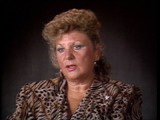
In mid-January 1945, as Soviet forces approached the Auschwitz concentration camp complex, the SS began evacuating Auschwitz and its subcamps.
SS units forced nearly 60,000 prisoners to march west from the Auschwitz camp system. Thousands had been killed in the camps in the days before these death marches began.
Tens of thousands of prisoners, mostly Jews, were forced to march either northwest for 55 kilometers (approximately 30 miles) to Gliwice (Gleiwitz) or due west for 63 kilometers (approximately 35 miles) to Wodzislaw (Loslau) in the western part of Upper Silesia. Those forced to march northwest were joined by prisoners from subcamps in East Upper Silesia, such as Bismarckhuette, Althammer, and Hindenburg. Those forced to march due west were joined by inmates from the subcamps to the south of Auschwitz, such as Jawischowitz, Tschechowitz, and Golleschau.
SS guards shot anyone who fell behind or could not continue. Prisoners also suffered from the cold weather, starvation, and exposure on these marches. At least 3,000 prisoners died on route to Gliwice alone. Possibly as many as 15,000 prisoners died during the evacuation marches from Auschwitz and the subcamps.
Upon arrival in Gliwice and Wodzislaw, the prisoners were put on unheated freight trains and transported to concentration camps in Germany, particularly to Flossenbürg , Sachsenhausen , Gross-Rosen , Buchenwald , Dachau , and also to Mauthausen in Austria. The rail journey lasted for days. Without food, water, shelter, or blankets, many prisoners did not survive the transport.
In late January 1945, SS and police officials forced 4,000 prisoners to evacuate Blechhammer on foot. Blechhammer was a subcamp of Auschwitz-Monowitz. The SS murdered about 800 prisoners during the march to the Gross-Rosen concentration camp. SS officials also killed as many as 200 prisoners left behind in Blechhammer as a result of illness or unsuccessful attempts to hide. After a brief delay, the SS transported around 3,000 Blechhammer prisoners from Gross-Rosen to the Buchenwald concentration camp in Germany.
The Liberation of Auschwitz
On January 27, 1945, the Soviet army entered Auschwitz, Birkenau, and Monowitz and liberated about seven thousand prisoners, most of whom were ill and dying.
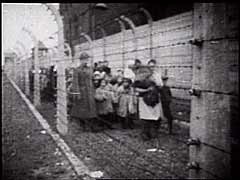
Series: Auschwitz

Auschwitz: Key Dates

Tattoos and Numbers: The System of Identifying Prisoners at Auschwitz
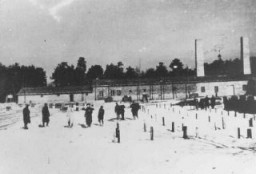
Administration of the Auschwitz Camp Complex
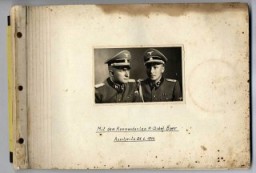
Collections Highlight: Auschwitz Through the Lens of the SS
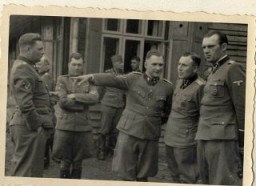
Auschwitz Through the Lens of the SS: The Album
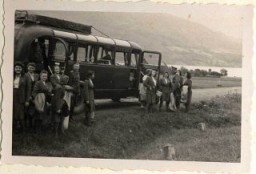
Auschwitz Through the Lens of the SS: A Tale of Two Albums
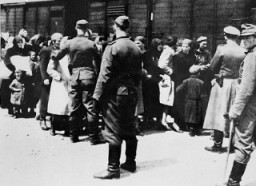
Auschwitz Through the Lens of the SS: Frankfurt Trial

The United States and the Holocaust: Why Auschwitz was not Bombed
Series: auschwitz subcamps, blechhammer, fürstengrube, series: killing centers.

Killing Centers: An Overview
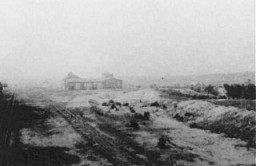
Operation Reinhard (Einsatz Reinhard)

Deportations to Killing Centers
Killing centers: in depth, switch series, critical thinking questions.
- Why has the Auschwitz complex become a symbol of the Holocaust?
- Besides the SS, what organizations or professions were involved in the design, construction, and operation of the camp?
- Were the German and Polish populations aware of Auschwitz, its purposes, and the conditions within? How would you begin to research this question?
Further Reading
Berenbaum, Michael, and Yisrael Gutman, editors. Anatomy of the Auschwitz Death Camp . Bloomington: Indiana University Press, 1998.
Cywinski, Piotr, Piotr Setkiewicz, and Jacek Lachendro. Auschwitz from A to Z. An Illustrated History of the Camp . Oswiecim: Auschwitz-Birkenau State Museum, 2013.
Dlugoborski, Waclaw et al. Auschwitz, 1940–1945: Central Issues in the History of the Camp . Oswiecim: Auschwitz-Birkenau State Museum, 2000.
Langbein, Hermann. People in Auschwitz . Chapel Hill: University of North Carolina Press, 2004.
Levi, Primo. Survival in Auschwitz: The Nazi Assault on Humanity . New York: Collier Books, 1986.
Rees, Laurence. Auschwitz: A New History . New York: Public Affairs, 2005.
Swiebocka, Teresa, editor. Auschwitz: A History in Photographs . Bloomington: Indiana University Press; Warsaw: Ksiazka i Wiedza, 1993.
Thank you for supporting our work
We would like to thank Crown Family Philanthropies and the Abe and Ida Cooper Foundation for supporting the ongoing work to create content and resources for the Holocaust Encyclopedia. View the list of all donors .
- International edition
- Australia edition
- Europe edition
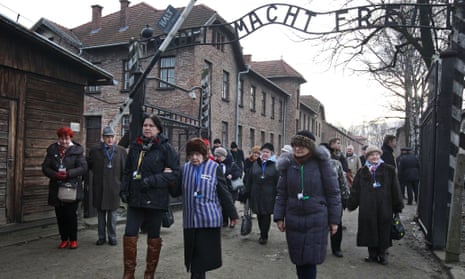
‘The biggest task is to combat indifference’: Auschwitz Museum turns visitors’ eyes to current events
Director wants visit to former Nazi concentration camp to spark reflection on ‘silence of bystanders’
P iotr Cywiński has spent a lot of time pondering a question that has exercised historians, philosophers and politicians ever since the end of the second world war. What lessons should we draw from one of the darkest pages in human history, the organised mass killing at Auschwitz?
A 49-year-old Polish historian, Cywiński has been director of the Auschwitz Museum since 2006. His office is housed in a former hospital and pharmacy built for the camp’s SS guards, and his windows look out over a crematorium and gas chamber.
“The biggest task for remembrance today is to combat indifference,” he said in an interview ahead of the 77th anniversary of the liberation of Auschwitz, which is also Holocaust Memorial Day, and is marked on Thursday.
“You can massacre tens of thousands of Rohingya, you can put 1.5 million Uyghurs in camps, in Yemen people are suffering because they do not have anything to eat, and we don’t feel concerned in our world,” he said.
Nazi Germany deported about 1.3 million people to Auschwitz and 1.1 million of them died there, 90% of them Jewish. The museum, on the edge of the Polish town of Oświęcim, is housed in the preserved original buildings of the Auschwitz concentration camp, and the ruins of the neighbouring Birkenau extermination camp.
Cywiński said that while the events of the Holocaust could not be compared to the present day, “the silence of bystanders” is a topic he wants visitors to the museum to think about and apply to their own lives.
As well as combatting a world in which indifference and ignorance about the Holocaust are rising, Cywiński also has to contend with the current Polish government, which has made a nationalist narrative emphasising Polish martyrdom and suffering a major part of its political message.
The government funds the Auschwitz museum and appoints its director, and Cywiński’s tenure is up for renewal at the end of this year. Many fear he may be replaced by a more ideological pro-government figure, as has happened at some other Polish museums. The Polish culture ministry said it was “premature” to discuss whether he would be reappointed later this year.
The Auschwitz Museum contains some of the most shocking and disturbing exhibits on display anywhere in the world. Once seen, they remain etched into the minds of many visitors for the rest of their lives: the two tonnes of human hair, the tens of thousands of shoes and the piles of suitcases with names scrawled on the sides, symbols of the false hope with which many arrived at the camp.
Cywiński wants to retain these gruesome artefacts, aware of the dark power that radiates from their authenticity, but also to add a new part of the exhibition, that will focus on the SS and the Nazi camp administration.

“We have to show that this was not an isolated place that suddenly appeared but it was a project that was created, built and grew during that time,” he said.
At the ceremony to mark 75 years of liberation in 2020 , Auschwitz survivor Marian Turski told the assembled dignitaries that “Auschwitz did not fall from the sky”. He warned of the dangers of discriminating against any minority. “Democracy hinges on the rights of minorities being protected,” he said.
While the museum will remain firmly focused on the terrible events that happened there, Cywiński is this week launching the Auschwitz Pledge Foundation, which will distribute grants to groups across the world fighting indifference to hatred.
The foundation’s general director, Jacek Kastelaniec, said projects that tackled antisemitism, racism, misogyny, homophobia, transphobia and discrimination against migrants and refugees would all be eligible for funding.
This is where things get tricky for Cywiński, given that he serves at the pleasure of a government that has frequently demonised refugees, and recently ran a presidential campaign based almost entirely around anti-LGBT rhetoric .
In a 2017 speech at Auschwitz, the then prime minister, Beata Szydło, said the history of the camp showed that “everything must be done to defend the safety and the lives of citizens”. The remarks were widely interpreted as a defence of the government’s anti-migration policy.
Last year, the government put Szydło on to the board of a council that oversees the Auschwitz Museum’s activities, leading three of its members to resign.
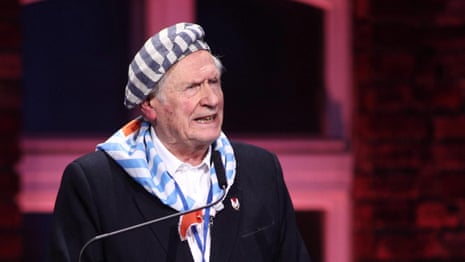
“The basic idea of the historical policy the government represents is to whitewash anything that is seen as a problem in Polish history at that time … I was afraid that they would try to impose those attitudes,” said Stanisław Krajewski, a philosopher and Jewish community leader, who was one of those who resigned in protest at Szydło’s appointment.
Cywiński said he did not have a problem with politicians being involved in the council, but said they should not have input into the narrative of the museum. He evaded a direct question about whether the inclusion of Szydło on the council has led to any changes or pressure.
“Personally I try every time to keep this place far from politics. It’s a moral place, it’s not a place that should change every four or five years with elections,” he said.
In written responses to questions, the Polish culture ministry said the appointment of Szydło “substantially strengthens the council and raises its importance” and that those who resigned had “no substantive justification” for doing so.
It also noted part of a new exhibition at the Auschwitz museum, which will culminate in a list of more than 1,200 Poles who assisted prisoners at Auschwitz.
More than 70,000 non-Jewish Poles also died at Auschwitz, and many in Poland feel that the overwhelming tragedy of the Holocaust has obscured the enormous Polish losses during the years of occupation and war. Inside the country, the government has focused overwhelmingly on Polish suffering, a narrative that means more Polish people now associate Auschwitz with “Polish martyrdom” than with “the destruction of the Jews”.
Jan Grabowski, a Polish-Canadian historian, said Cywiński had gone too far in his cooperation with government-linked figures and institutions pushing this distorted version of history. “Auschwitz has become part and parcel of Polish history policy, in other words, transforming Auschwitz into part of the Polish feelgood narrative,” he said.

Last year, Grabowski was forced to stand trial along with fellow historian Barbara Engelking over a book they co-authored that detailed instances of Polish complicity in Nazi crimes against Jews. (The appeals court overturned an initial ruling against them.) The government has tried to focus attention on cases of Poles who were killed for helping Jews.
Cywiński said he did not see a problem with marking these heroes, but said: “We have to remember that others were supportive of the Nazi regime.”
He criticised the increasing use of history by politicians, but took care to say it was a global problem and not just a Polish one. “When I turn on the television and I hear people speaking about history, 90% of the time it’s not a historian, it’s a politician. It was not like this 20 years ago,” he said.
Cywiński would rather focus on how to get visitors to take lessons away from Auschwitz they can apply to their own lives. Many of the museum guides – of which there are currently 340 who work in 21 different languages – say that the best time to make visitors think about their own moral choices is when, overcome with the visceral horror of the museum exhibits, they ask why the world did not do more to stop the Holocaust from taking place.
This is the perfect time to speak about “the silence of bystanders”, said Cywiński.
“I cannot say to people, ‘Now you have to help Yemen’; ‘Now you should help the Uyghurs’. It is not my role to tell them what to do. But it is our role to help them ask the question, ‘What can I do in this world? Why is it a problem if I stay indifferent?’”
- Antisemitism
Most viewed
A Visit to Auschwitz Exhibition in Boston Recalls One of History’s Darkest Periods
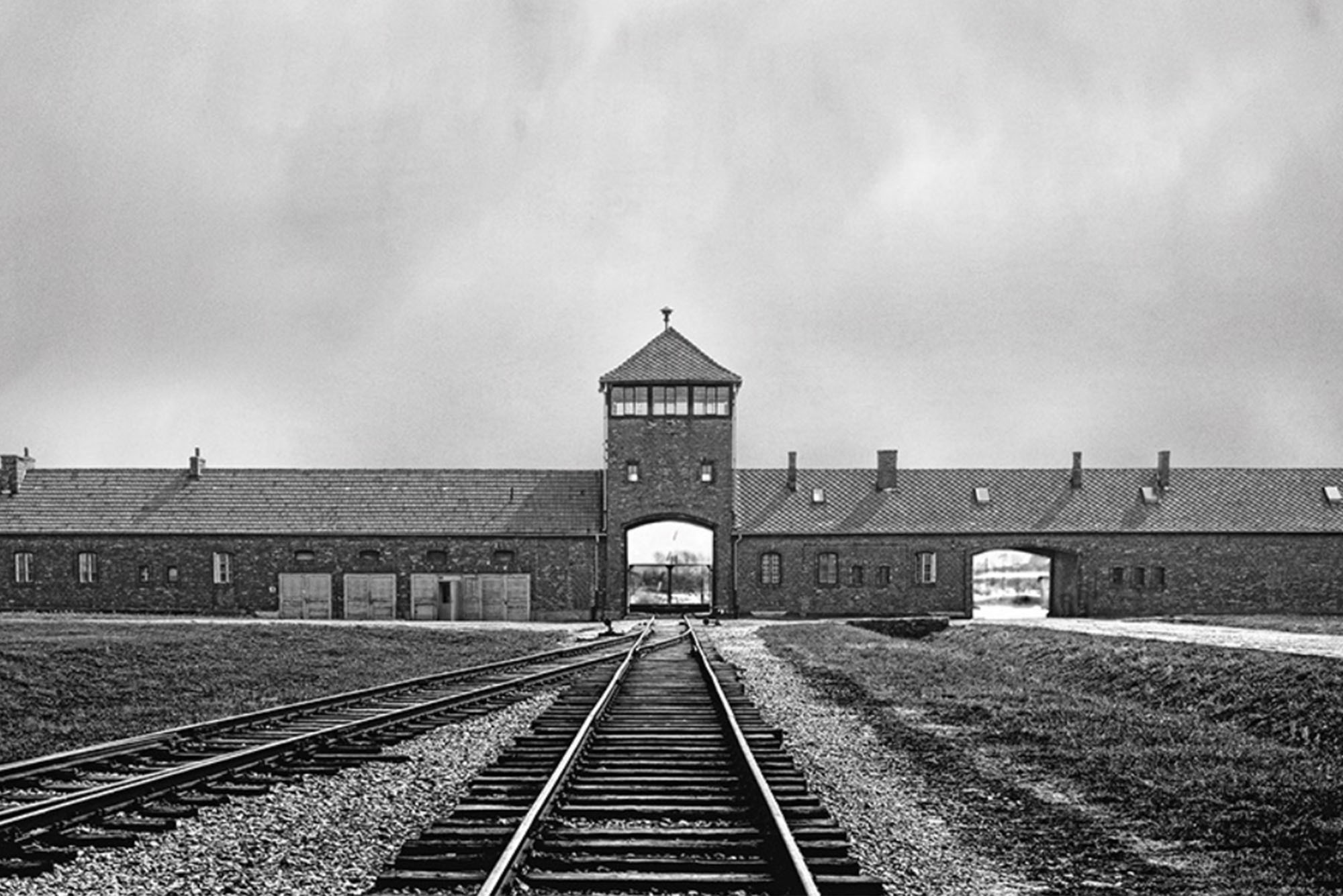
The traveling exhibition Auschwitz. Not Long Ago. Not Far Away, which includes some 700 artifacts, many from Auschwitz, the Nazis’ largest concentration camp, is on view in Boston through September 2. Photos by Musealia
Auschwitz. Not Long Ago. Not Far Away provides “a potent reminder of the importance of the past in understanding our present,” says Nancy Harrowitz, director of BU’s Elie Wiesel Center for Jewish Studies
John o’rourke.
A powerful exhibition recalling the horrors of the Holocaust has just opened in Boston. Auschwitz. Not Long Ago. Not Far Away includes more than 700 artifacts from what was the largest concentration camp established by the Nazis during World War II under German Chancellor Adolf Hitler. More than one million people died there between 1940 and 1945.
The traveling exhibition represents an extraordinary collaboration among more than 20 museums across the globe, including the Auschwitz-Birkenau Memorial and Museum, the Anne Frank House, and Yad Vashem, and it is described as the first traveling exhibition on Auschwitz. It is on view at the Castle at Park Plaza through September 2.
The show arrives in Boston at a time of rising antisemitism and bias crimes in the United States and around the world, giving it a particular urgency. The show is arranged chronologically. Among the hundreds of objects included are suitcases that were packed by Jews deported to Auschwitz, portions of an original prison barrack, concrete posts that served as part of the fence that surrounded the camp, a single woman’s red shoe set against a photo of hundreds of shoes confiscated from Auschwitz detainees on their way to the gas chambers, a child’s doll, hundreds of buttons removed from detainees’ clothing, and much more. The vast collection of personal objects is meant to humanize the lives lost at Auschwitz and to serve as a remembrance and as a reminder of the need to combat hate and evil wherever it exists.
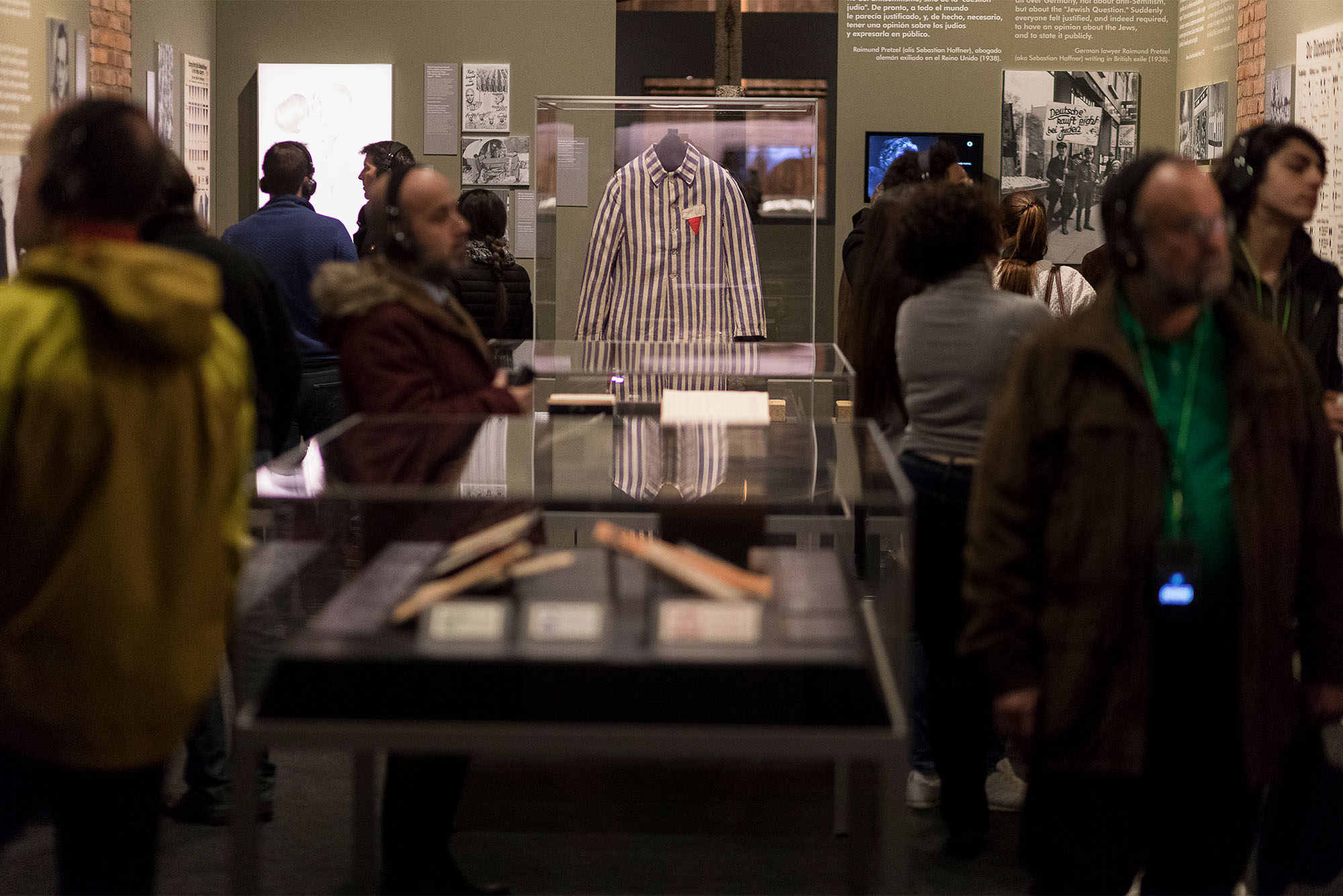
Since opening in late March, the exhibition has attracted sellout crowds. Among the first people to see it was Nancy Harrowitz , director of Boston University’s Elie Wiesel Center for Jewish Studies , a College of Arts & Sciences professor of Italian and of Jewish studies, and director of the University’s major in Holocaust, Genocide, and Human Rights Studies . BU Today asked her to share her impressions about the show.
With Nancy Harrowitz
Bu today: what struck you the most about auschwitz. not long ago. not far away .
Nancy Harrowitz: The crowds in attendance: a lot of people were very interested in seeing it, most tickets for that weekend had sold out, and the large crowd the day I was there was quiet and very absorbed in the experience.
BU Today: What was the mood like the day you attended?
Nancy Harrowitz: Somber, sad, respectful. Some people were visibly overwhelmed. There was a hush in the rooms that was particularly noticeable considering how many people were in attendance.
BU Today: You’ve seen numerous exhibitions about the Holocaust. How is this one different?
Nancy Harrowitz: This one offers more artifacts and mini videos than most I’ve seen, including survivor testimonies.
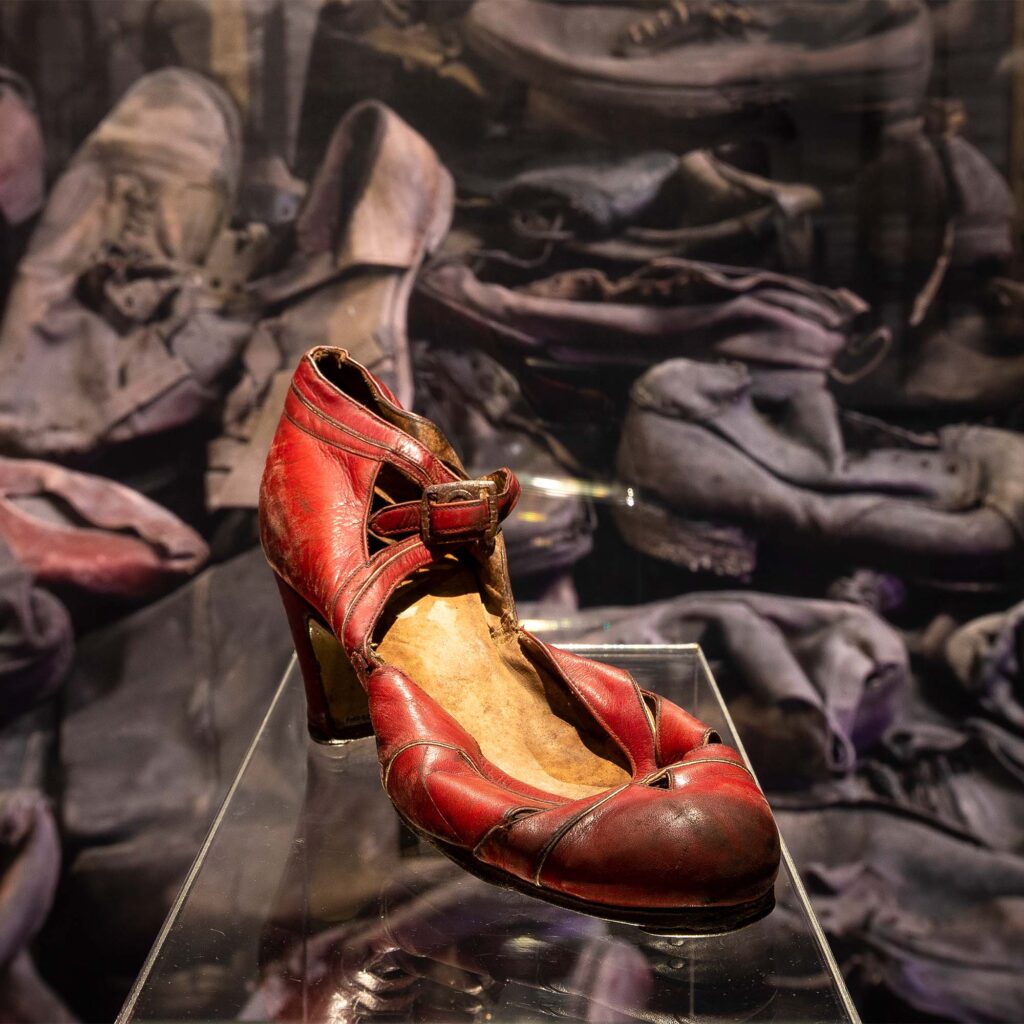
A woman’s dress shoe (from left), a pair of spectacles, and buttons from garments taken from detainees on their way to the gas chamber are among the hundreds of objects on view in Auschwitz. Not Long Ago. Not Far Away.
BU Today: What is the exhibition’s greatest strength, in your mind?
The sheer number of physical objects, including artifacts, in a rather small space. The tall poles holding barbed wire, used at the camp, made a very strong impression. Overall, I think that because of all the artifacts and visual presentations, and a crowded feeling in the rooms that are so full of material, the exhibition was able to bring visitors a little closer to the possibility of imagining the physical camp and taking in what happened there.
BU Today: The title of the show seems to suggest that one of the exhibition’s goals is to remind visitors that the horror of Auschwitz is not some long-ago event.
This powerful title not only evokes Auschwitz as part of our not-so-distant past, it [also] evokes it as a possible present and future, grimly reminding us that the conditions that produced the Holocaust are not so far from our society as we’d like to think.
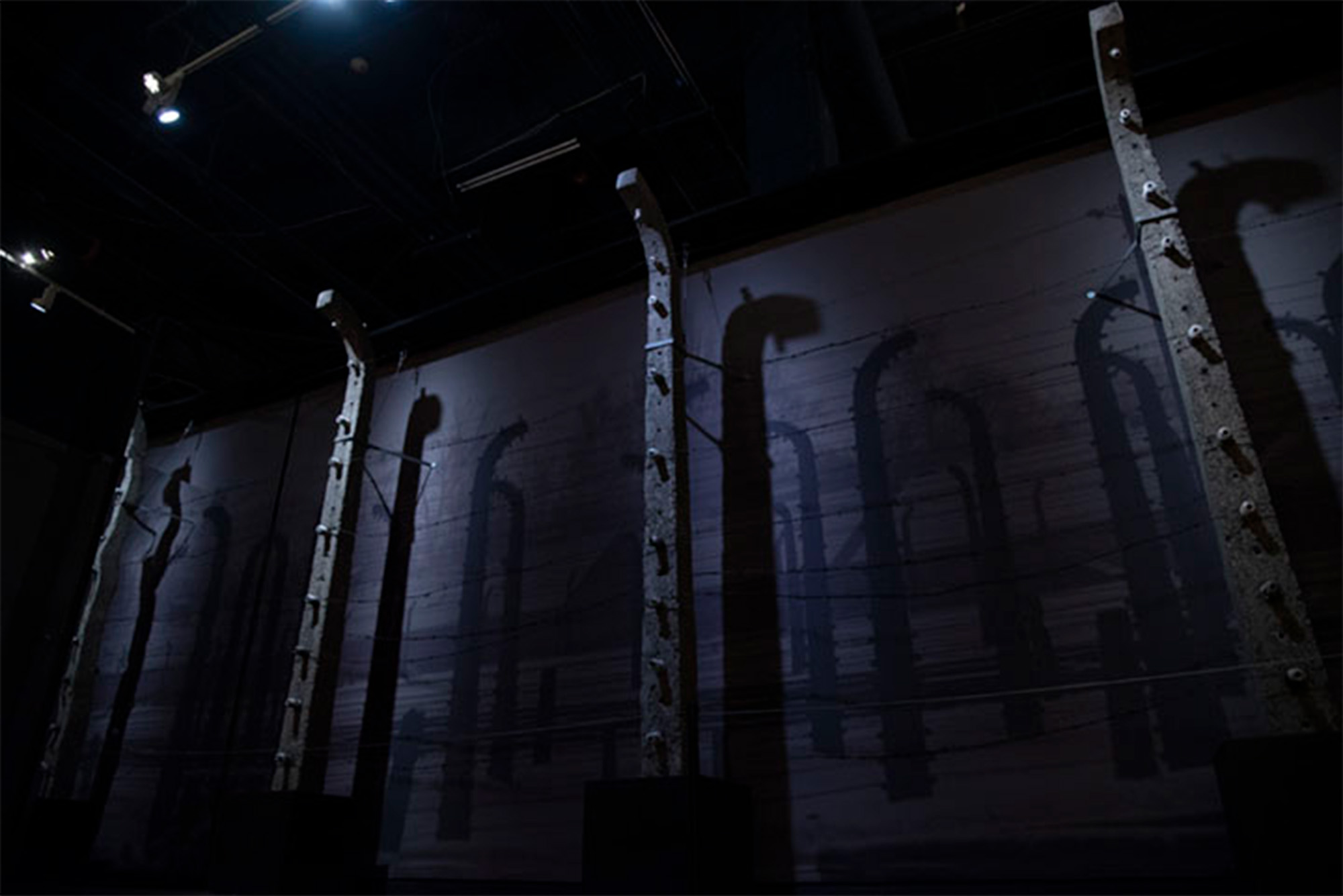
BU Today: There are more than 700 artifacts on display here. Were there one or two that you found particularly powerful?
The iconic barbed wire towers. They are frequently seen in films and documentaries about Auschwitz. To see them in person, so to speak, was chilling, even frightening. It brought past visual experiences to the immediate present.
BU Today: The exhibition arrives in Boston at a time of rising antisemitism and growing denial of the Holocaust’s existence. How important is an event like this in conveying the atrocities that happened?
The exhibition is very important, considering the timing of what’s happening today. I noticed a deep absorption on the part of the people who were there: more intense than I’ve seen at other museums. I had a couple of conversations with other attendees, who referenced the growing antisemitism of our time. One couple had been there for over three hours, and were completely immersed in the experience. I thought it significant that most people were reading every panel and looking at everything exhibited with great attention and focus.
BU Today: What do you hope visitors take away from seeing the show?
I hope they leave with a better understanding of the consequences of dehumanization, bigotry, and hate, and a deeper knowledge of the conditions that led to the Holocaust and its atrocities.
BU Today: In your view, why is it important for people to see this exhibition?
To learn about this tragic history and to pay more attention to warning signs, such as we are experiencing today. It’s a very important exhibition and well worth seeing. It also provides a potent reminder of the importance of the past in understanding our present.
Auschwitz. Not Long Ago. Not Far Away is on view at the Castle at Park Plaza, 130 Columbus Ave., Boston, through September 2. Tickets start at $27.95. Discounts are available for children, seniors, and groups of 10 or more. Book tickets here. The show is recommended for ages 12-plus. See a trailer for the exhibition here .
Explore Related Topics:
- Exhibitions
- Share this story
- 1 Comments Add
Editor, BU Today
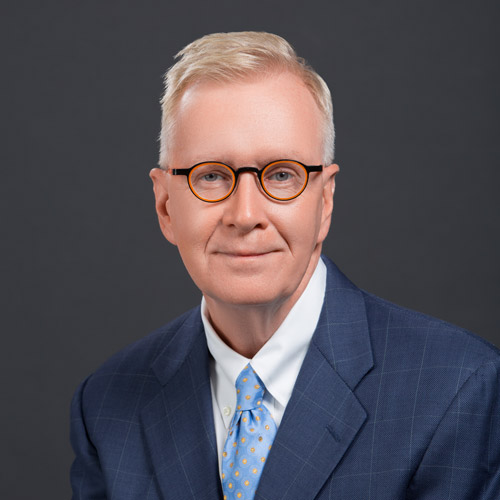
John O’Rourke began his career as a reporter at The MacNeil/Lehrer NewsHour . He has worked as a producer at World Monitor , a coproduction of the Christian Science Monitor and the Discovery Channel, and NBC News, where he was a producer for several shows, including Now with Tom Brokaw and Katie Couric , NBC Nightly News , and The Today Show . John has won many awards, including four Emmys, a George Foster Peabody Award, and five Edward R. Murrow Awards. Profile
Comments & Discussion
Boston University moderates comments to facilitate an informed, substantive, civil conversation. Abusive, profane, self-promotional, misleading, incoherent or off-topic comments will be rejected. Moderators are staffed during regular business hours (EST) and can only accept comments written in English. Statistics or facts must include a citation or a link to the citation.
There is 1 comment on A Visit to Auschwitz Exhibition in Boston Recalls One of History’s Darkest Periods
I haven’t visited yet, but I shall. It is humbling to realize that I, too, am part of the same humanity that did such things to other humans.
Post a comment. Cancel reply
Your email address will not be published. Required fields are marked *
Latest from BU Today
Waste watchers, bu honors best student employees and supervisor, women’s tennis heads to annapolis this weekend for 2024 patriot league tournament, reimagining cummington mall, pov: baseball needs to shake up the game—or risk a slow death, meet bu’s diy bicycle repair shop, women’s golf going for fourth patriot league title this weekend, the weekender: april 18 to 21, louis chude-sokei brings bu, spoken word, and dub reggae sounds to venice biennale, can i fall in love with ai, bu’s macklin celebrini wins 2024 hobey baker memorial award, learn more about bu spark bu’s innovation and experiential learning lab, bu student aviator soars to new heights, pov: policymakers are entitled to their own opinions. but should they be entitled to their own science, bu falls 2-1 in overtime in 2024 ncaa semifinal, bu ras authorize four-day strike over contract negotiations, ai task force report recommends critical embrace of technology and cautious use of ai-detector apps, a wrinkle in time closes out wheelock family theatre’s 2023–2024 season, bu softball hosts holy cross in 2024 patriot league home opener.
Biden's new Title IX rules protect LGBTQ students, but trans sports rule still on hold

The rights of LGBTQ students will be protected by federal law and victims of campus sexual assault will gain new safeguards under rules finalized Friday by the Biden administration.
The new provisions are part of a revised Title IX regulation issued by the Education Department, fulfilling a campaign pledge by President Joe Biden. He had promised to dismantle rules created by former Education Secretary Betsy DeVos , who added new protections for students accused of sexual misconduct.
Notably absent from Biden’s policy, however, is any mention of transgender athletes.
The administration originally planned to include a new policy forbidding schools from enacting outright bans on transgender athletes, but that provision was put on hold. The delay is widely seen as a political maneuver during an election year in which Republicans have rallied around bans on transgender athletes in girls’ sports.
Instead, Biden is officially undoing sexual assault rules put in place by his predecessor and current election-year opponent, former President Donald Trump. The final policy drew praise from victims’ advocates, while Republicans said it erodes the rights of accused students.
The new rule makes “crystal clear that everyone can access schools that are safe, welcoming and that respect their rights,” Education Secretary Miguel Cardona said.
“No one should face bullying or discrimination just because of who they are, who they love,” Cardona told reporters. “Sadly, this happens all too often.”
Biden’s regulation is meant to clarify schools’ obligations under Title IX , the 1972 women’s rights law that outlaws discrimination based on sex in education. It applies to colleges and elementary and high schools that receive federal money. The update is to take effect in August.
Among the biggest changes is new recognition that Title IX protects LGBTQ students — a source of deep conflict with Republicans.
The 1972 law doesn’t directly address the issue, but the new rules clarify that Title IX also forbids discrimination based on sexual orientation or gender identity. LGBTQ students who face discrimination will be entitled to a response from their school under Title IX, and those failed by their schools can seek recourse from the federal government.
Many Republicans say Congress never intended such protections under Title IX. A federal judge previously blocked Biden administration guidance to the same effect after 20 Republican-led states challenged the policy .
Rep. Virginia Foxx, a Republican from North Carolina and chair of the House Education and the Workforce Committee, said the new regulation threatens decades of advancement for women and girls.
“This final rule dumps kerosene on the already raging fire that is Democrats’ contemptuous culture war that aims to radically redefine sex and gender,” Foxx said in a statement.
The revision was proposed nearly two years ago but has been slowed by a comment period that drew 240,000 responses, a record for the Education Department.
Many of the changes are meant to ensure that schools and colleges respond to complaints of sexual misconduct. In general, the rules widen the type of misconduct that institutions are required to address, and it grants more protections to students who bring accusations.
Chief among the changes is a wider definition of sexual harassment. Schools now must address any unwelcome sex-based conduct that is so “severe or pervasive” that it limits a student’s equal access to an education.
Under the DeVos rules, conduct had to be “severe, pervasive and objectively offensive,” a higher bar that pushed some types of misconduct outside the purview of Title IX.
Colleges will no longer be required to hold live hearings to allow students to cross-examine one another through representatives — a signature provision from the DeVos rules.
Live hearings are allowed under the Biden rules, but they’re optional and carry new limits. Students must be able to participate from hearings remotely, for example, and schools must bar questions that are “unclear or harassing.”
As an alternative to live hearings, college officials can interview students separately, allowing each student to suggest questions and get a recording of the responses.
Those hearings were a major point of contention with victims’ advocates, who said it forced sexual assault survivors to face their attackers and discouraged people from reporting assaults. Supporters said it gave accused students a fair process to question their accusers, arguing that universities had become too quick to rule against accused students.
Victims’ advocates applauded the changes and urged colleges to implement them quickly.
“After years of pressure from students and survivors of sexual violence, the Biden Administration’s Title IX update will make schools safer and more accessible for young people, many of whom experienced irreparable harm while they fought for protection and support,” said Emma Grasso Levine, a senior manager at the group Know Your IX.
Despite the focus on safeguards for victims, the new rules preserve certain protections for accused students.
All students must have equal access to present evidence and witnesses under the new policy, and all students must have equal access to evidence. All students will be allowed to bring an advisor to campus hearings, and colleges must have an appeals process.
In general, accused students won’t be able to be disciplined until after they’re found responsible for misconduct, although the regulation allows for “emergency” removals if it’s deemed a matter of campus safety.
The latest overhaul continues a back-and-forth political battle as presidential administrations repeatedly rewrite the rules around campus sexual misconduct.
The DeVos rules were themselves an overhaul of an Obama-era policy that was intended to force colleges to take accusations of campus sexual assault more seriously. Now, after years of nearly constant changes, some colleges have been pushing for a political middle ground to end the whiplash.
The Associated Press

IMAGES
VIDEO
COMMENTS
Before the visit please read " the rules for visiting ". • The grounds and buildings of the Auschwitz I and Auschwitz II-Birkenau camps are open to visitors. The duration of a visit is determined solely by the individual interests and needs of the visitors. As a minimum, however, at least three-and-a-half hours should be reserved.
Preparation to a visit - online lesson. The first part of the lesson presents basic information about the Nazi ideology - how the Nazi party came to power in Germany, how it reduced democracy and liquidated political opponents, and how the antisemitic policy escalated. The second part describes the concepts of "protective detention" in the ...
website (visit.auschwitz.org) and at the Visitors Service Centre, according to the Terms and Conditions for reservations and purchases of Entry Passes. 13. The number of persons simultaneously visiting the Museum grounds is limited for ... [email protected]. § 2 Rules of order 1. Visitors to the grounds of the Museum should ...
Entry cards are available at visit.auschwitz.org at "online individual visit" section. The online tour lasts about two hours and is divided into two parts - in Auschwitz I and Birkenau. The guide's narration is conducted live. Additionally, the educator will also use multimedia materials, archival photographs, artistic works, documents, and ...
An individual visitor will be able to enter the Auschwitz Memorial in the first available time slot in between the hours for individual visitors without an educator. Visitors who made a group reservation with an educator will have to reserve another entry time. These groups must start the visit at the specified time.
Visitor Guidelines and Safety Measures. The health and safety of our visitors, staff, and volunteers are our highest priority. To help reduce the risk of transmission of COVID-19, the Museum is open with visitor requirements and safety measures in place. Free timed-entry tickets are required to enter the Museum's Permanent Exhibition only.
On busy days, over 30,000 tourists will walk through the grounds of Auschwitz. Dozens and dozens of tours run simultaneously through the old camp and Birkenau, a few minutes down the road. As such, they run a pretty efficient ship. When you arrive you sign up for a tour time and are equipped with a pass, headset and radio.
7:30-19:00 in June, July, and August. The closing time means the last entrance - after that, you are allowed to stay on-site for an hour and a half. However, if you want to see Auschwitz Museum properly, you need at least 3,5 hours for that - that's also how long the standard tour with the educator lasts.
Tourists at Auschwitz II-Birkenau. 1) visit as part of a group organised by a Kraków tourist agency, 2) visit independently and join a guided tour at the museum, or 3) visit independently for free without a guide. Unfortunately, a new online reservation system now makes the latter two options much more difficult than in the past.
A strange heaviness hung in the air at the Auschwitz-Birkenau State Museum, about an hour and a half east of Krakow, Poland.Visitors slipped quietly in and out of a series of large brick buildings ...
Visiting Auschwitz tours, the site of one of the most infamous concentration and extermination camps from World War II, requires careful planning to ensure a meaningful and respectful experience…
In the Auschwitz camps, it is estimated that over 1.3 million people were brought including over a million Jews. Of those brought to the camp, over 1,100,000 people were killed the majority of which were gassed and cremated. About 90% of the victims were Jews. For ever let this place be a cry of despair.
After visiting Auschwitz I in March 1941, it appears that Himmler ordered that the camp be expanded, although Peter Hayes notes that, on 10 January 1941, ... Prisoners could be beaten and killed by guards and kapos for the slightest infraction of the rules.
Official guidelines from memorial staff recommend that those under 14 do not visit. But this is just a recommendation, not a rule. The gates to Auschwitz Birkenau concentration camp, Poland ©Shutterstock. The remarkable plasticity of the teenage brain means there is an opportunity during these years to fundamentally affect, for good or ill ...
Auschwitz, the largest and arguably the most notorious of all the Nazi death camps, opened in the spring of 1940. Its first commandant was Rudolf Höss (1900-47), who previously had helped run the ...
Auschwitz left its mark as one of the most infamous camps of the Holocaust. Key Facts. 1. Located in German-occupied Poland, Auschwitz consisted of three camps including a killing center. The camps were opened over the course of nearly two years, 1940-1942. Auschwitz closed in January 1945 with its liberation by the Soviet army.
In a 2017 speech at Auschwitz, the then prime minister, Beata Szydło, said the history of the camp showed that "everything must be done to defend the safety and the lives of citizens".
Auschwitz, Nazi Germany's largest concentration camp and extermination camp. Located near the town of Oswiecim in southern Poland, Auschwitz was actually three camps in one: a prison camp, an extermination camp, and a slave-labor camp. Between 1.1 and 1.5 million people died there; 90 percent of them were Jews.
A powerful exhibition recalling the horrors of the Holocaust has just opened in Boston. Auschwitz. Not Long Ago. Not Far Away includes more than 700 artifacts from what was the largest concentration camp established by the Nazis during World War II under German Chancellor Adolf Hitler. More than one million people died there between 1940 and 1945.
A witness reported a man setting himself on fire in the designated protest area outside of the Trump trial in New York City. It is unclear what led the man to take the action.
It's been nearly 80 years since the end of the Holocaust, but the harrowing experiences of survivors are still coming to light. One of those stories is the focus of a new Peacock series, "The ...
The Federal Aviation Administration (FAA) is issuing new rules and guidelines to combat reports of fatigue among air traffic controllers. To lower the risk of exhaustion and burnout, the ...
April 19, 2024, 8:52 AM PDT. By Rob Wile. The Federal Aviation Administration is instituting new rest rules for U.S. air traffic controllers to address fatigue issues that may be degrading air ...
The rights of LGBTQ students will be protected by federal law and victims of campus sexual assault will gain new safeguards under rules finalized by the Biden administration.
Boris Johnson breached government rules by being "evasive" about his relationship with a company that set up a meeting between him and Venezuela's president, the business appointments ...